Understanding Postpartum Depression
VerifiedAdded on 2020/05/11
|19
|5094
|70
AI Summary
This assignment delves into the multifaceted issue of postpartum depression. It requires a critical analysis of provided research articles focusing on various aspects such as predictive biomarkers, cultural influences on immigrant women, clinical phenotypes, and the experience of postnatal depression among immigrant mothers in Western countries. The analysis should encompass risk factors, symptom onset, diagnostic challenges, and potential interventions.
Contribute Materials
Your contribution can guide someone’s learning journey. Share your
documents today.
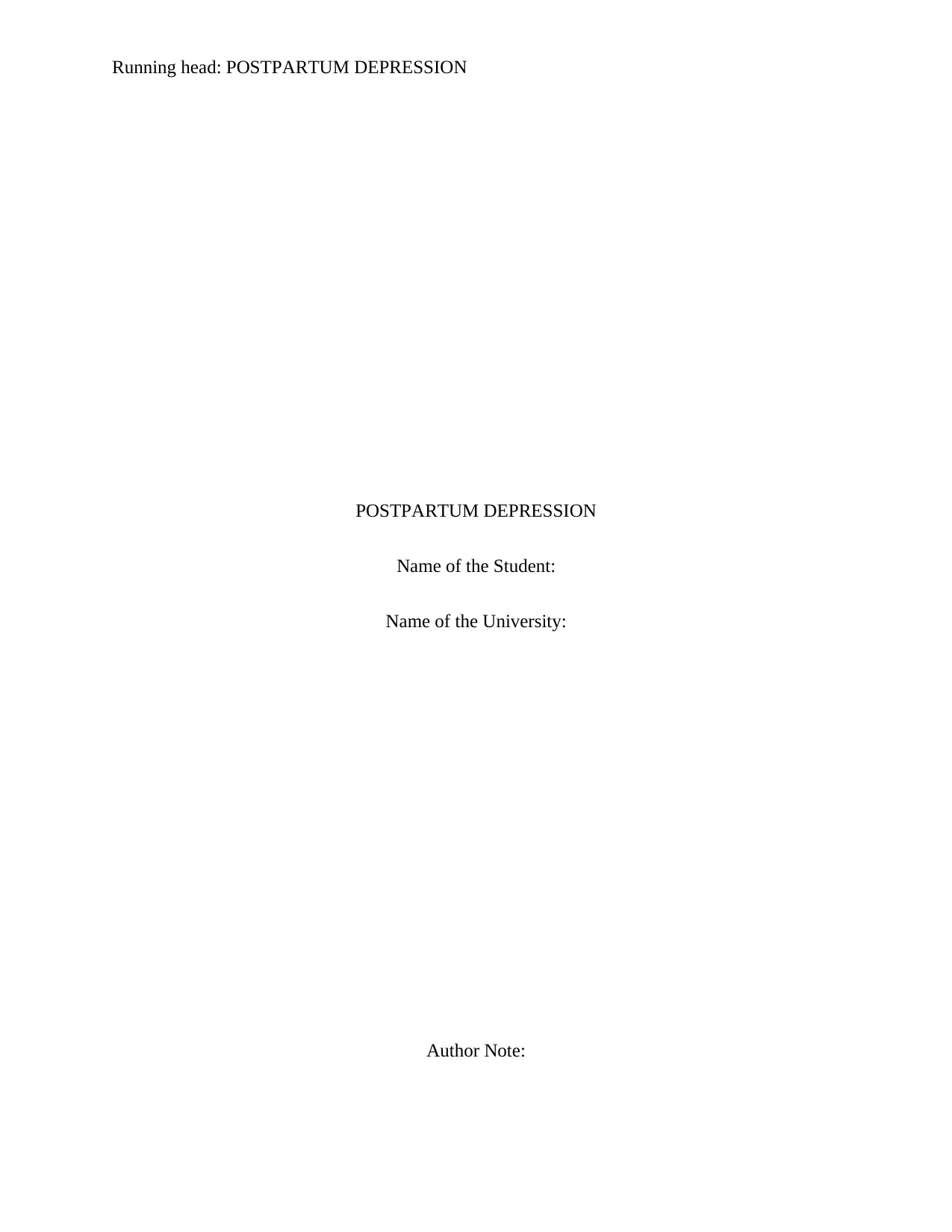
Running head: POSTPARTUM DEPRESSION
POSTPARTUM DEPRESSION
Name of the Student:
Name of the University:
Author Note:
POSTPARTUM DEPRESSION
Name of the Student:
Name of the University:
Author Note:
Secure Best Marks with AI Grader
Need help grading? Try our AI Grader for instant feedback on your assignments.
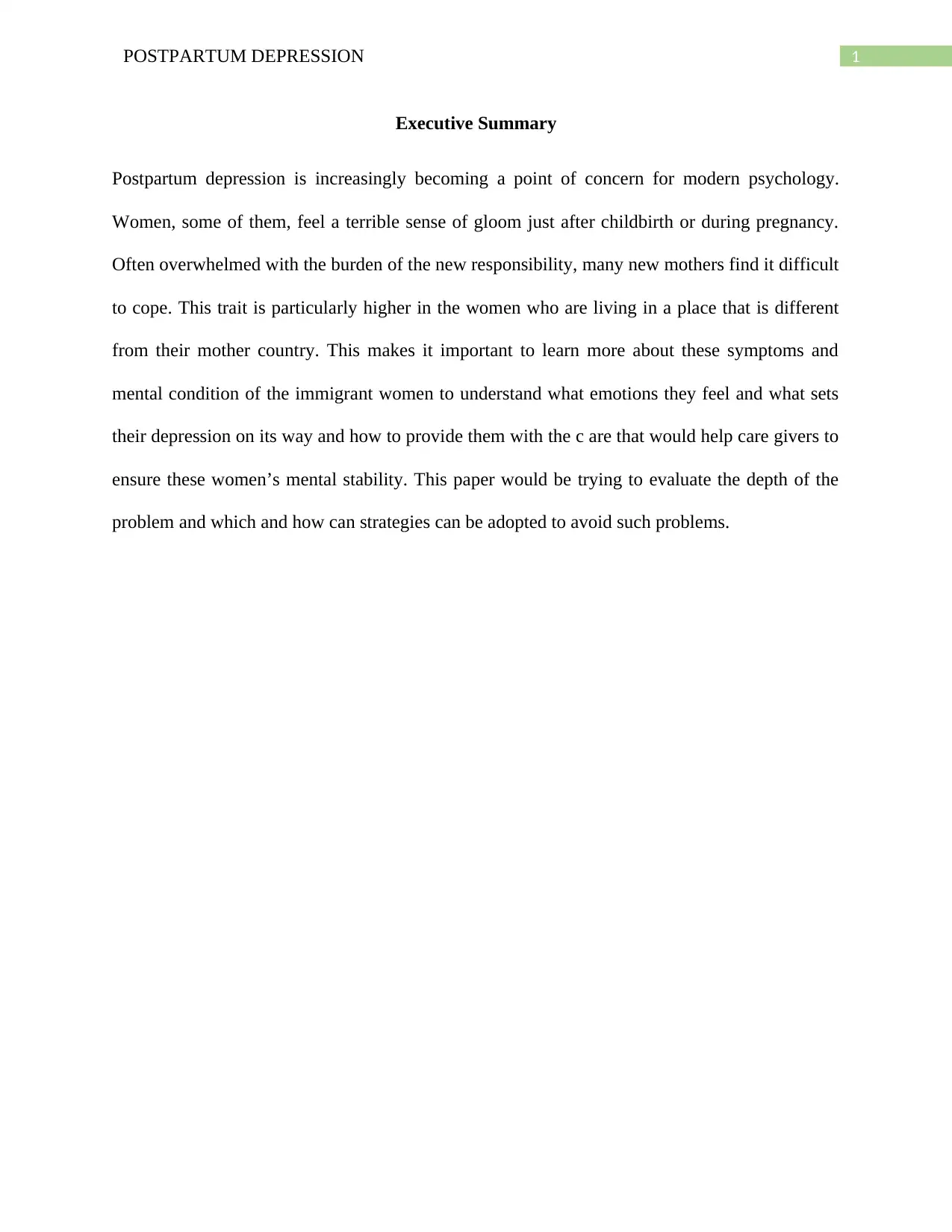
1POSTPARTUM DEPRESSION
Executive Summary
Postpartum depression is increasingly becoming a point of concern for modern psychology.
Women, some of them, feel a terrible sense of gloom just after childbirth or during pregnancy.
Often overwhelmed with the burden of the new responsibility, many new mothers find it difficult
to cope. This trait is particularly higher in the women who are living in a place that is different
from their mother country. This makes it important to learn more about these symptoms and
mental condition of the immigrant women to understand what emotions they feel and what sets
their depression on its way and how to provide them with the c are that would help care givers to
ensure these women’s mental stability. This paper would be trying to evaluate the depth of the
problem and which and how can strategies can be adopted to avoid such problems.
Executive Summary
Postpartum depression is increasingly becoming a point of concern for modern psychology.
Women, some of them, feel a terrible sense of gloom just after childbirth or during pregnancy.
Often overwhelmed with the burden of the new responsibility, many new mothers find it difficult
to cope. This trait is particularly higher in the women who are living in a place that is different
from their mother country. This makes it important to learn more about these symptoms and
mental condition of the immigrant women to understand what emotions they feel and what sets
their depression on its way and how to provide them with the c are that would help care givers to
ensure these women’s mental stability. This paper would be trying to evaluate the depth of the
problem and which and how can strategies can be adopted to avoid such problems.
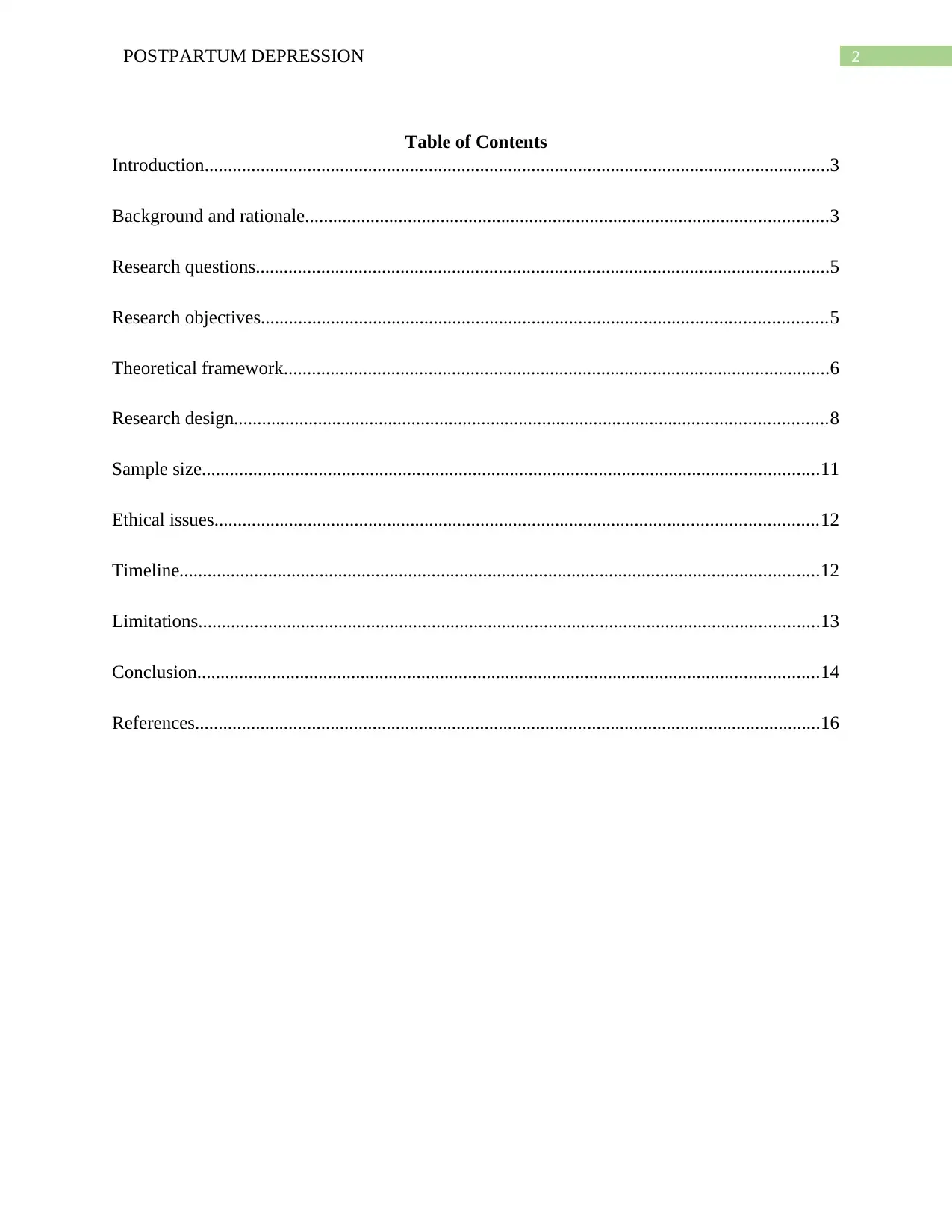
2POSTPARTUM DEPRESSION
Table of Contents
Introduction......................................................................................................................................3
Background and rationale................................................................................................................3
Research questions...........................................................................................................................5
Research objectives.........................................................................................................................5
Theoretical framework.....................................................................................................................6
Research design...............................................................................................................................8
Sample size....................................................................................................................................11
Ethical issues.................................................................................................................................12
Timeline.........................................................................................................................................12
Limitations.....................................................................................................................................13
Conclusion.....................................................................................................................................14
References......................................................................................................................................16
Table of Contents
Introduction......................................................................................................................................3
Background and rationale................................................................................................................3
Research questions...........................................................................................................................5
Research objectives.........................................................................................................................5
Theoretical framework.....................................................................................................................6
Research design...............................................................................................................................8
Sample size....................................................................................................................................11
Ethical issues.................................................................................................................................12
Timeline.........................................................................................................................................12
Limitations.....................................................................................................................................13
Conclusion.....................................................................................................................................14
References......................................................................................................................................16
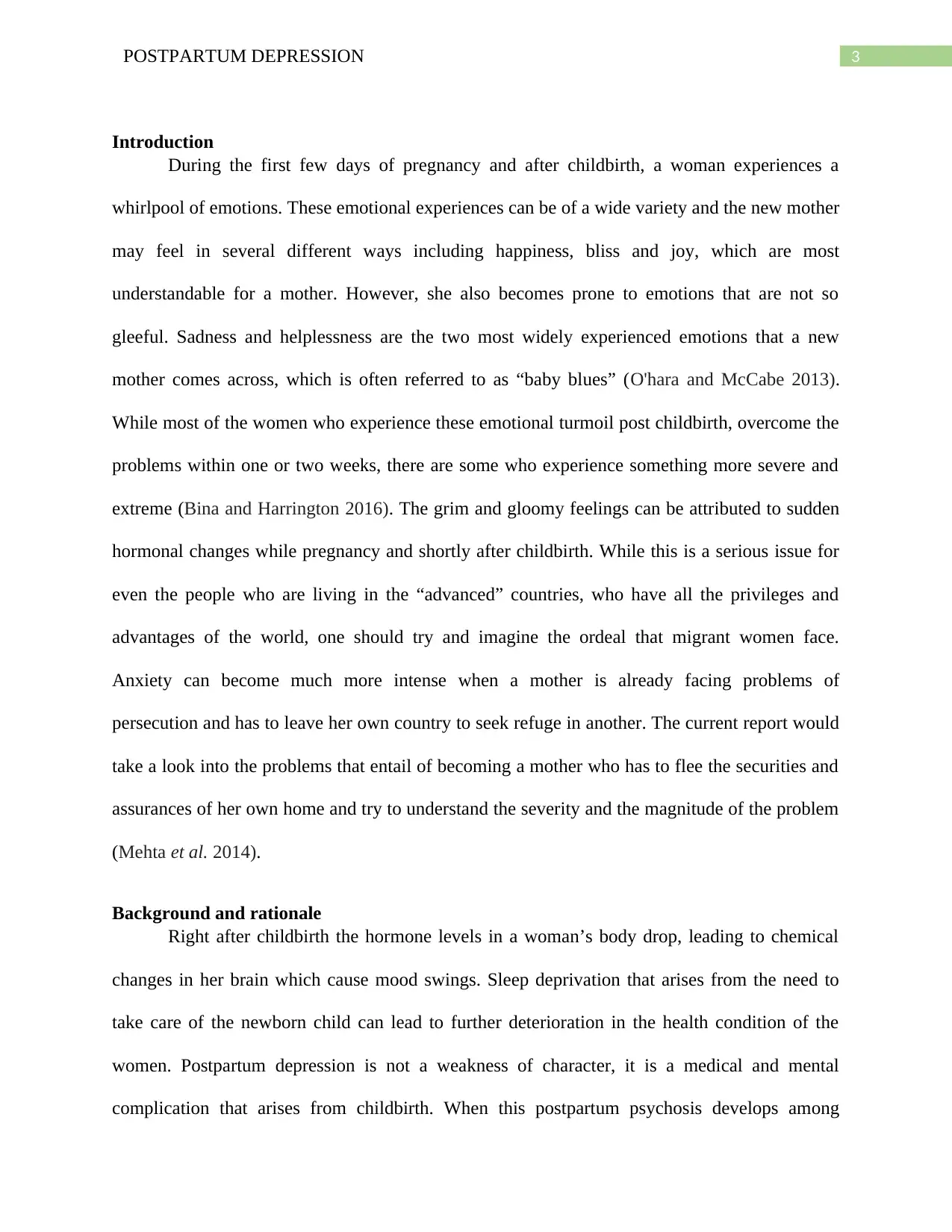
3POSTPARTUM DEPRESSION
Introduction
During the first few days of pregnancy and after childbirth, a woman experiences a
whirlpool of emotions. These emotional experiences can be of a wide variety and the new mother
may feel in several different ways including happiness, bliss and joy, which are most
understandable for a mother. However, she also becomes prone to emotions that are not so
gleeful. Sadness and helplessness are the two most widely experienced emotions that a new
mother comes across, which is often referred to as “baby blues” (O'hara and McCabe 2013).
While most of the women who experience these emotional turmoil post childbirth, overcome the
problems within one or two weeks, there are some who experience something more severe and
extreme (Bina and Harrington 2016). The grim and gloomy feelings can be attributed to sudden
hormonal changes while pregnancy and shortly after childbirth. While this is a serious issue for
even the people who are living in the “advanced” countries, who have all the privileges and
advantages of the world, one should try and imagine the ordeal that migrant women face.
Anxiety can become much more intense when a mother is already facing problems of
persecution and has to leave her own country to seek refuge in another. The current report would
take a look into the problems that entail of becoming a mother who has to flee the securities and
assurances of her own home and try to understand the severity and the magnitude of the problem
(Mehta et al. 2014).
Background and rationale
Right after childbirth the hormone levels in a woman’s body drop, leading to chemical
changes in her brain which cause mood swings. Sleep deprivation that arises from the need to
take care of the newborn child can lead to further deterioration in the health condition of the
women. Postpartum depression is not a weakness of character, it is a medical and mental
complication that arises from childbirth. When this postpartum psychosis develops among
Introduction
During the first few days of pregnancy and after childbirth, a woman experiences a
whirlpool of emotions. These emotional experiences can be of a wide variety and the new mother
may feel in several different ways including happiness, bliss and joy, which are most
understandable for a mother. However, she also becomes prone to emotions that are not so
gleeful. Sadness and helplessness are the two most widely experienced emotions that a new
mother comes across, which is often referred to as “baby blues” (O'hara and McCabe 2013).
While most of the women who experience these emotional turmoil post childbirth, overcome the
problems within one or two weeks, there are some who experience something more severe and
extreme (Bina and Harrington 2016). The grim and gloomy feelings can be attributed to sudden
hormonal changes while pregnancy and shortly after childbirth. While this is a serious issue for
even the people who are living in the “advanced” countries, who have all the privileges and
advantages of the world, one should try and imagine the ordeal that migrant women face.
Anxiety can become much more intense when a mother is already facing problems of
persecution and has to leave her own country to seek refuge in another. The current report would
take a look into the problems that entail of becoming a mother who has to flee the securities and
assurances of her own home and try to understand the severity and the magnitude of the problem
(Mehta et al. 2014).
Background and rationale
Right after childbirth the hormone levels in a woman’s body drop, leading to chemical
changes in her brain which cause mood swings. Sleep deprivation that arises from the need to
take care of the newborn child can lead to further deterioration in the health condition of the
women. Postpartum depression is not a weakness of character, it is a medical and mental
complication that arises from childbirth. When this postpartum psychosis develops among
Secure Best Marks with AI Grader
Need help grading? Try our AI Grader for instant feedback on your assignments.
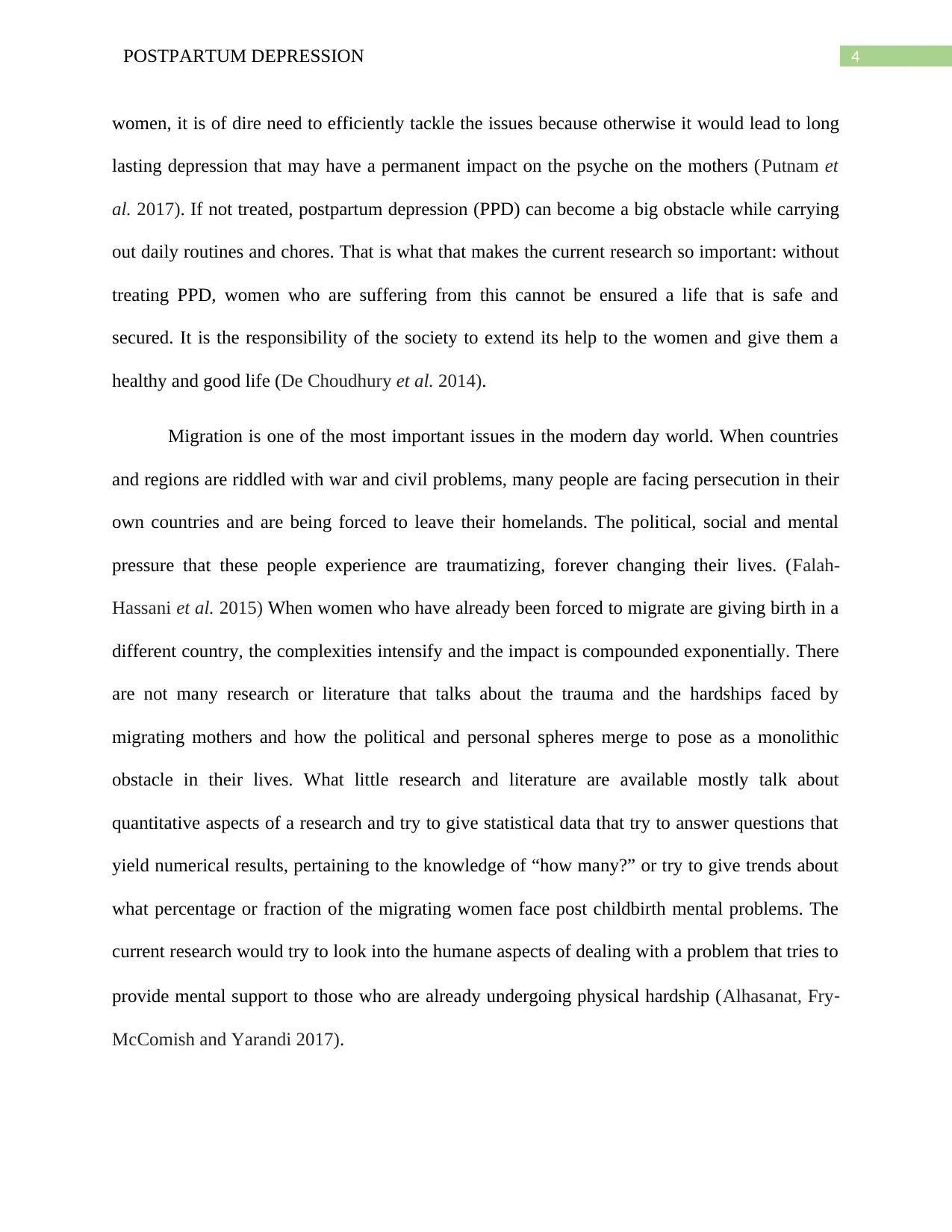
4POSTPARTUM DEPRESSION
women, it is of dire need to efficiently tackle the issues because otherwise it would lead to long
lasting depression that may have a permanent impact on the psyche on the mothers (Putnam et
al. 2017). If not treated, postpartum depression (PPD) can become a big obstacle while carrying
out daily routines and chores. That is what that makes the current research so important: without
treating PPD, women who are suffering from this cannot be ensured a life that is safe and
secured. It is the responsibility of the society to extend its help to the women and give them a
healthy and good life (De Choudhury et al. 2014).
Migration is one of the most important issues in the modern day world. When countries
and regions are riddled with war and civil problems, many people are facing persecution in their
own countries and are being forced to leave their homelands. The political, social and mental
pressure that these people experience are traumatizing, forever changing their lives. (Falah-
Hassani et al. 2015) When women who have already been forced to migrate are giving birth in a
different country, the complexities intensify and the impact is compounded exponentially. There
are not many research or literature that talks about the trauma and the hardships faced by
migrating mothers and how the political and personal spheres merge to pose as a monolithic
obstacle in their lives. What little research and literature are available mostly talk about
quantitative aspects of a research and try to give statistical data that try to answer questions that
yield numerical results, pertaining to the knowledge of “how many?” or try to give trends about
what percentage or fraction of the migrating women face post childbirth mental problems. The
current research would try to look into the humane aspects of dealing with a problem that tries to
provide mental support to those who are already undergoing physical hardship (Alhasanat, Fry‐
McComish and Yarandi 2017).
women, it is of dire need to efficiently tackle the issues because otherwise it would lead to long
lasting depression that may have a permanent impact on the psyche on the mothers (Putnam et
al. 2017). If not treated, postpartum depression (PPD) can become a big obstacle while carrying
out daily routines and chores. That is what that makes the current research so important: without
treating PPD, women who are suffering from this cannot be ensured a life that is safe and
secured. It is the responsibility of the society to extend its help to the women and give them a
healthy and good life (De Choudhury et al. 2014).
Migration is one of the most important issues in the modern day world. When countries
and regions are riddled with war and civil problems, many people are facing persecution in their
own countries and are being forced to leave their homelands. The political, social and mental
pressure that these people experience are traumatizing, forever changing their lives. (Falah-
Hassani et al. 2015) When women who have already been forced to migrate are giving birth in a
different country, the complexities intensify and the impact is compounded exponentially. There
are not many research or literature that talks about the trauma and the hardships faced by
migrating mothers and how the political and personal spheres merge to pose as a monolithic
obstacle in their lives. What little research and literature are available mostly talk about
quantitative aspects of a research and try to give statistical data that try to answer questions that
yield numerical results, pertaining to the knowledge of “how many?” or try to give trends about
what percentage or fraction of the migrating women face post childbirth mental problems. The
current research would try to look into the humane aspects of dealing with a problem that tries to
provide mental support to those who are already undergoing physical hardship (Alhasanat, Fry‐
McComish and Yarandi 2017).
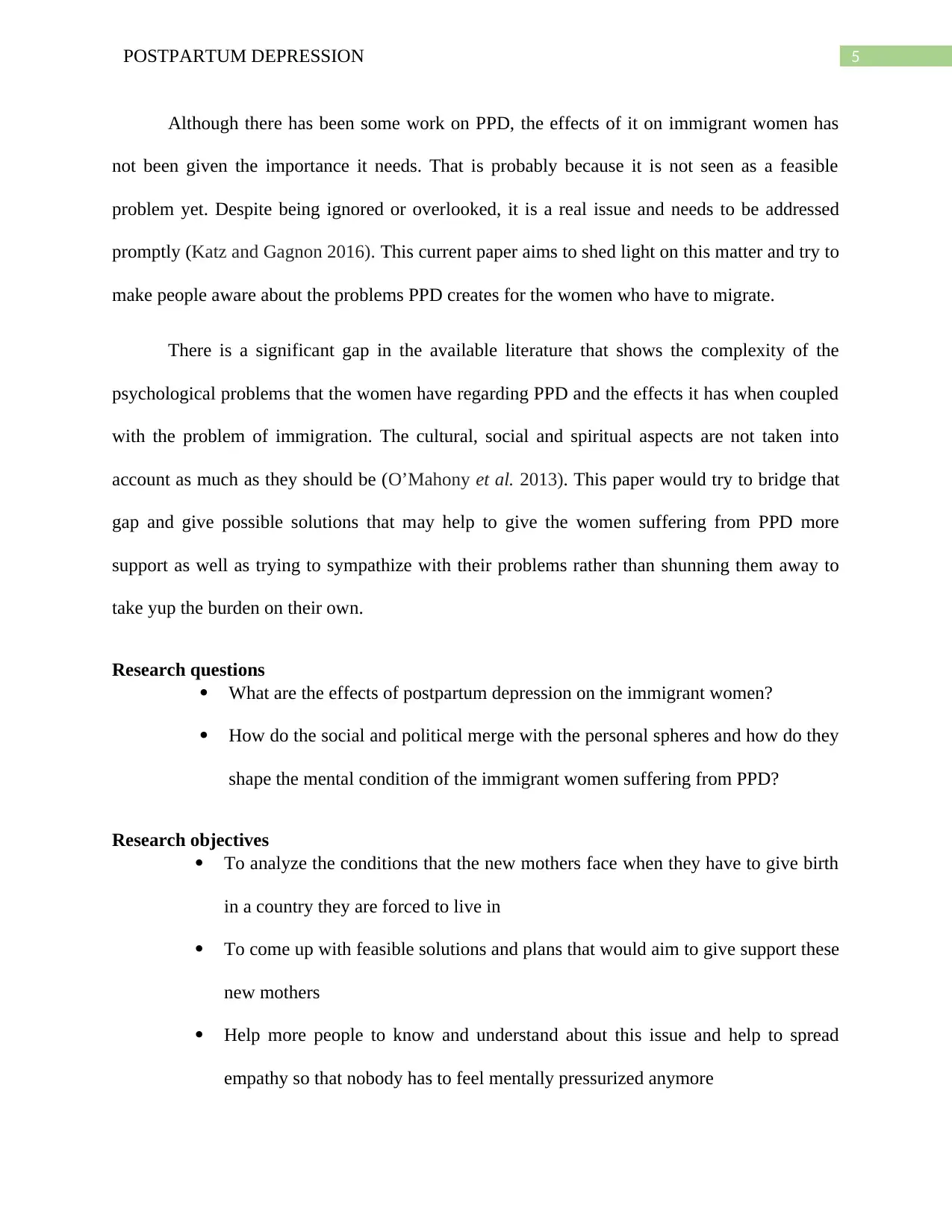
5POSTPARTUM DEPRESSION
Although there has been some work on PPD, the effects of it on immigrant women has
not been given the importance it needs. That is probably because it is not seen as a feasible
problem yet. Despite being ignored or overlooked, it is a real issue and needs to be addressed
promptly (Katz and Gagnon 2016). This current paper aims to shed light on this matter and try to
make people aware about the problems PPD creates for the women who have to migrate.
There is a significant gap in the available literature that shows the complexity of the
psychological problems that the women have regarding PPD and the effects it has when coupled
with the problem of immigration. The cultural, social and spiritual aspects are not taken into
account as much as they should be (O’Mahony et al. 2013). This paper would try to bridge that
gap and give possible solutions that may help to give the women suffering from PPD more
support as well as trying to sympathize with their problems rather than shunning them away to
take yup the burden on their own.
Research questions
What are the effects of postpartum depression on the immigrant women?
How do the social and political merge with the personal spheres and how do they
shape the mental condition of the immigrant women suffering from PPD?
Research objectives
To analyze the conditions that the new mothers face when they have to give birth
in a country they are forced to live in
To come up with feasible solutions and plans that would aim to give support these
new mothers
Help more people to know and understand about this issue and help to spread
empathy so that nobody has to feel mentally pressurized anymore
Although there has been some work on PPD, the effects of it on immigrant women has
not been given the importance it needs. That is probably because it is not seen as a feasible
problem yet. Despite being ignored or overlooked, it is a real issue and needs to be addressed
promptly (Katz and Gagnon 2016). This current paper aims to shed light on this matter and try to
make people aware about the problems PPD creates for the women who have to migrate.
There is a significant gap in the available literature that shows the complexity of the
psychological problems that the women have regarding PPD and the effects it has when coupled
with the problem of immigration. The cultural, social and spiritual aspects are not taken into
account as much as they should be (O’Mahony et al. 2013). This paper would try to bridge that
gap and give possible solutions that may help to give the women suffering from PPD more
support as well as trying to sympathize with their problems rather than shunning them away to
take yup the burden on their own.
Research questions
What are the effects of postpartum depression on the immigrant women?
How do the social and political merge with the personal spheres and how do they
shape the mental condition of the immigrant women suffering from PPD?
Research objectives
To analyze the conditions that the new mothers face when they have to give birth
in a country they are forced to live in
To come up with feasible solutions and plans that would aim to give support these
new mothers
Help more people to know and understand about this issue and help to spread
empathy so that nobody has to feel mentally pressurized anymore
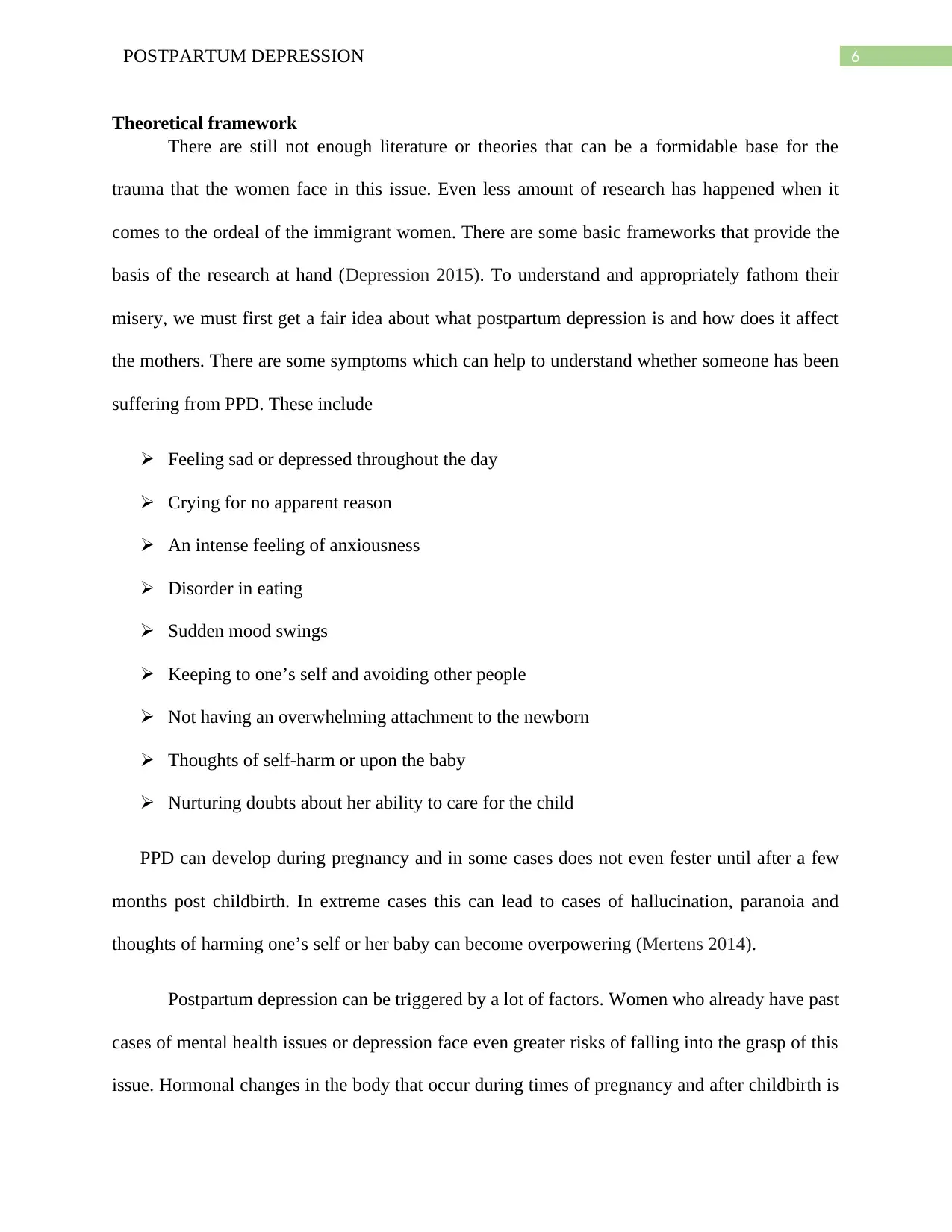
6POSTPARTUM DEPRESSION
Theoretical framework
There are still not enough literature or theories that can be a formidable base for the
trauma that the women face in this issue. Even less amount of research has happened when it
comes to the ordeal of the immigrant women. There are some basic frameworks that provide the
basis of the research at hand (Depression 2015). To understand and appropriately fathom their
misery, we must first get a fair idea about what postpartum depression is and how does it affect
the mothers. There are some symptoms which can help to understand whether someone has been
suffering from PPD. These include
Feeling sad or depressed throughout the day
Crying for no apparent reason
An intense feeling of anxiousness
Disorder in eating
Sudden mood swings
Keeping to one’s self and avoiding other people
Not having an overwhelming attachment to the newborn
Thoughts of self-harm or upon the baby
Nurturing doubts about her ability to care for the child
PPD can develop during pregnancy and in some cases does not even fester until after a few
months post childbirth. In extreme cases this can lead to cases of hallucination, paranoia and
thoughts of harming one’s self or her baby can become overpowering (Mertens 2014).
Postpartum depression can be triggered by a lot of factors. Women who already have past
cases of mental health issues or depression face even greater risks of falling into the grasp of this
issue. Hormonal changes in the body that occur during times of pregnancy and after childbirth is
Theoretical framework
There are still not enough literature or theories that can be a formidable base for the
trauma that the women face in this issue. Even less amount of research has happened when it
comes to the ordeal of the immigrant women. There are some basic frameworks that provide the
basis of the research at hand (Depression 2015). To understand and appropriately fathom their
misery, we must first get a fair idea about what postpartum depression is and how does it affect
the mothers. There are some symptoms which can help to understand whether someone has been
suffering from PPD. These include
Feeling sad or depressed throughout the day
Crying for no apparent reason
An intense feeling of anxiousness
Disorder in eating
Sudden mood swings
Keeping to one’s self and avoiding other people
Not having an overwhelming attachment to the newborn
Thoughts of self-harm or upon the baby
Nurturing doubts about her ability to care for the child
PPD can develop during pregnancy and in some cases does not even fester until after a few
months post childbirth. In extreme cases this can lead to cases of hallucination, paranoia and
thoughts of harming one’s self or her baby can become overpowering (Mertens 2014).
Postpartum depression can be triggered by a lot of factors. Women who already have past
cases of mental health issues or depression face even greater risks of falling into the grasp of this
issue. Hormonal changes in the body that occur during times of pregnancy and after childbirth is
Paraphrase This Document
Need a fresh take? Get an instant paraphrase of this document with our AI Paraphraser
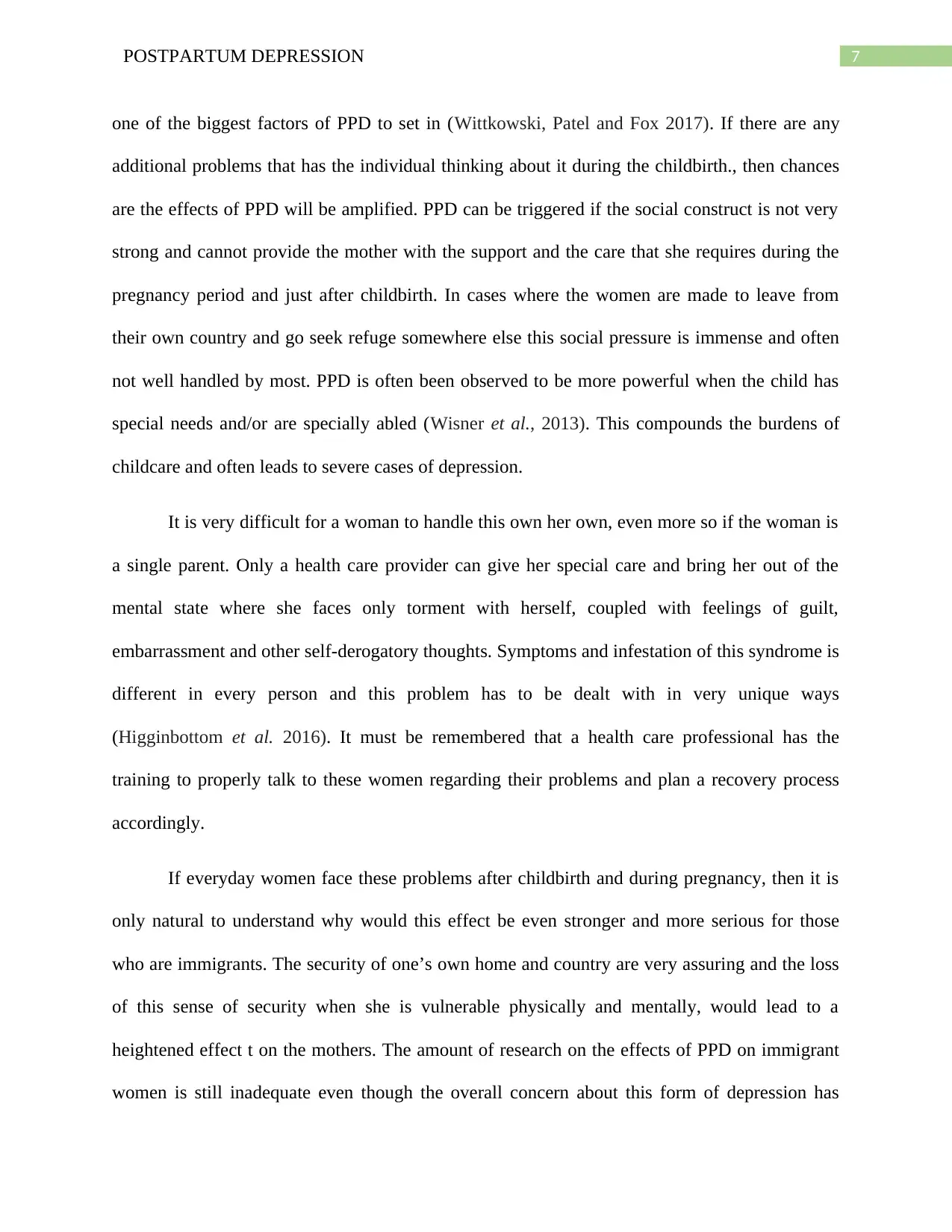
7POSTPARTUM DEPRESSION
one of the biggest factors of PPD to set in (Wittkowski, Patel and Fox 2017). If there are any
additional problems that has the individual thinking about it during the childbirth., then chances
are the effects of PPD will be amplified. PPD can be triggered if the social construct is not very
strong and cannot provide the mother with the support and the care that she requires during the
pregnancy period and just after childbirth. In cases where the women are made to leave from
their own country and go seek refuge somewhere else this social pressure is immense and often
not well handled by most. PPD is often been observed to be more powerful when the child has
special needs and/or are specially abled (Wisner et al., 2013). This compounds the burdens of
childcare and often leads to severe cases of depression.
It is very difficult for a woman to handle this own her own, even more so if the woman is
a single parent. Only a health care provider can give her special care and bring her out of the
mental state where she faces only torment with herself, coupled with feelings of guilt,
embarrassment and other self-derogatory thoughts. Symptoms and infestation of this syndrome is
different in every person and this problem has to be dealt with in very unique ways
(Higginbottom et al. 2016). It must be remembered that a health care professional has the
training to properly talk to these women regarding their problems and plan a recovery process
accordingly.
If everyday women face these problems after childbirth and during pregnancy, then it is
only natural to understand why would this effect be even stronger and more serious for those
who are immigrants. The security of one’s own home and country are very assuring and the loss
of this sense of security when she is vulnerable physically and mentally, would lead to a
heightened effect t on the mothers. The amount of research on the effects of PPD on immigrant
women is still inadequate even though the overall concern about this form of depression has
one of the biggest factors of PPD to set in (Wittkowski, Patel and Fox 2017). If there are any
additional problems that has the individual thinking about it during the childbirth., then chances
are the effects of PPD will be amplified. PPD can be triggered if the social construct is not very
strong and cannot provide the mother with the support and the care that she requires during the
pregnancy period and just after childbirth. In cases where the women are made to leave from
their own country and go seek refuge somewhere else this social pressure is immense and often
not well handled by most. PPD is often been observed to be more powerful when the child has
special needs and/or are specially abled (Wisner et al., 2013). This compounds the burdens of
childcare and often leads to severe cases of depression.
It is very difficult for a woman to handle this own her own, even more so if the woman is
a single parent. Only a health care provider can give her special care and bring her out of the
mental state where she faces only torment with herself, coupled with feelings of guilt,
embarrassment and other self-derogatory thoughts. Symptoms and infestation of this syndrome is
different in every person and this problem has to be dealt with in very unique ways
(Higginbottom et al. 2016). It must be remembered that a health care professional has the
training to properly talk to these women regarding their problems and plan a recovery process
accordingly.
If everyday women face these problems after childbirth and during pregnancy, then it is
only natural to understand why would this effect be even stronger and more serious for those
who are immigrants. The security of one’s own home and country are very assuring and the loss
of this sense of security when she is vulnerable physically and mentally, would lead to a
heightened effect t on the mothers. The amount of research on the effects of PPD on immigrant
women is still inadequate even though the overall concern about this form of depression has
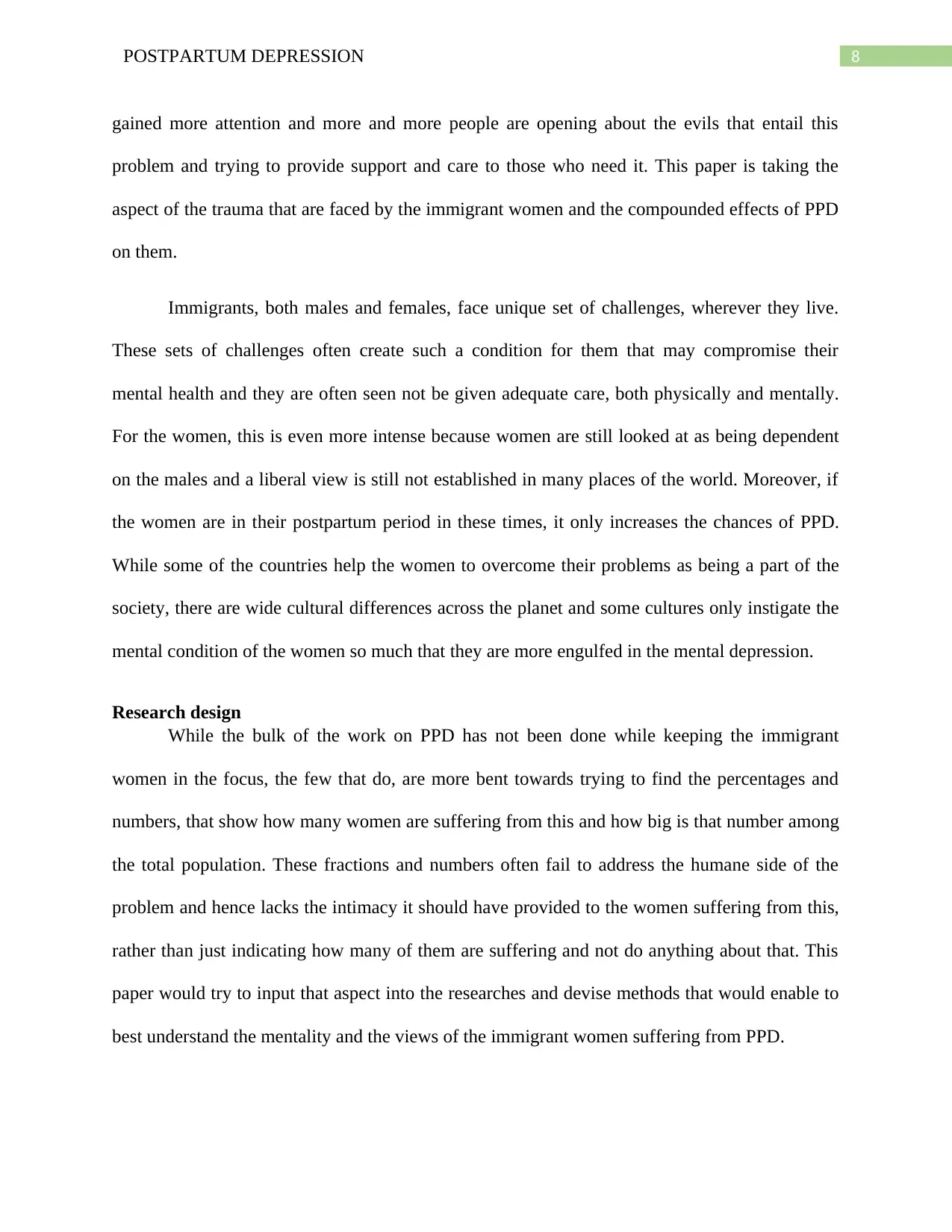
8POSTPARTUM DEPRESSION
gained more attention and more and more people are opening about the evils that entail this
problem and trying to provide support and care to those who need it. This paper is taking the
aspect of the trauma that are faced by the immigrant women and the compounded effects of PPD
on them.
Immigrants, both males and females, face unique set of challenges, wherever they live.
These sets of challenges often create such a condition for them that may compromise their
mental health and they are often seen not be given adequate care, both physically and mentally.
For the women, this is even more intense because women are still looked at as being dependent
on the males and a liberal view is still not established in many places of the world. Moreover, if
the women are in their postpartum period in these times, it only increases the chances of PPD.
While some of the countries help the women to overcome their problems as being a part of the
society, there are wide cultural differences across the planet and some cultures only instigate the
mental condition of the women so much that they are more engulfed in the mental depression.
Research design
While the bulk of the work on PPD has not been done while keeping the immigrant
women in the focus, the few that do, are more bent towards trying to find the percentages and
numbers, that show how many women are suffering from this and how big is that number among
the total population. These fractions and numbers often fail to address the humane side of the
problem and hence lacks the intimacy it should have provided to the women suffering from this,
rather than just indicating how many of them are suffering and not do anything about that. This
paper would try to input that aspect into the researches and devise methods that would enable to
best understand the mentality and the views of the immigrant women suffering from PPD.
gained more attention and more and more people are opening about the evils that entail this
problem and trying to provide support and care to those who need it. This paper is taking the
aspect of the trauma that are faced by the immigrant women and the compounded effects of PPD
on them.
Immigrants, both males and females, face unique set of challenges, wherever they live.
These sets of challenges often create such a condition for them that may compromise their
mental health and they are often seen not be given adequate care, both physically and mentally.
For the women, this is even more intense because women are still looked at as being dependent
on the males and a liberal view is still not established in many places of the world. Moreover, if
the women are in their postpartum period in these times, it only increases the chances of PPD.
While some of the countries help the women to overcome their problems as being a part of the
society, there are wide cultural differences across the planet and some cultures only instigate the
mental condition of the women so much that they are more engulfed in the mental depression.
Research design
While the bulk of the work on PPD has not been done while keeping the immigrant
women in the focus, the few that do, are more bent towards trying to find the percentages and
numbers, that show how many women are suffering from this and how big is that number among
the total population. These fractions and numbers often fail to address the humane side of the
problem and hence lacks the intimacy it should have provided to the women suffering from this,
rather than just indicating how many of them are suffering and not do anything about that. This
paper would try to input that aspect into the researches and devise methods that would enable to
best understand the mentality and the views of the immigrant women suffering from PPD.
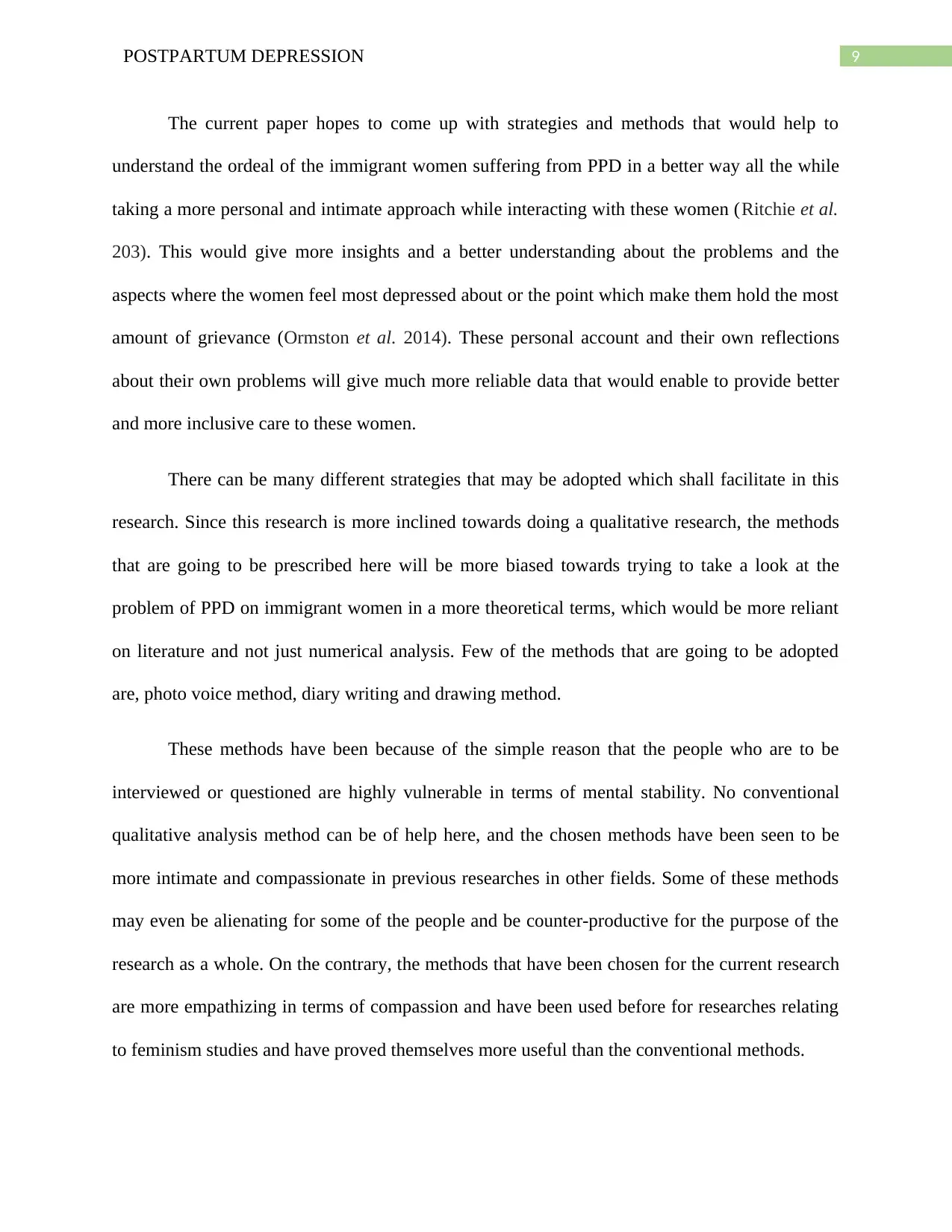
9POSTPARTUM DEPRESSION
The current paper hopes to come up with strategies and methods that would help to
understand the ordeal of the immigrant women suffering from PPD in a better way all the while
taking a more personal and intimate approach while interacting with these women (Ritchie et al.
203). This would give more insights and a better understanding about the problems and the
aspects where the women feel most depressed about or the point which make them hold the most
amount of grievance (Ormston et al. 2014). These personal account and their own reflections
about their own problems will give much more reliable data that would enable to provide better
and more inclusive care to these women.
There can be many different strategies that may be adopted which shall facilitate in this
research. Since this research is more inclined towards doing a qualitative research, the methods
that are going to be prescribed here will be more biased towards trying to take a look at the
problem of PPD on immigrant women in a more theoretical terms, which would be more reliant
on literature and not just numerical analysis. Few of the methods that are going to be adopted
are, photo voice method, diary writing and drawing method.
These methods have been because of the simple reason that the people who are to be
interviewed or questioned are highly vulnerable in terms of mental stability. No conventional
qualitative analysis method can be of help here, and the chosen methods have been seen to be
more intimate and compassionate in previous researches in other fields. Some of these methods
may even be alienating for some of the people and be counter-productive for the purpose of the
research as a whole. On the contrary, the methods that have been chosen for the current research
are more empathizing in terms of compassion and have been used before for researches relating
to feminism studies and have proved themselves more useful than the conventional methods.
The current paper hopes to come up with strategies and methods that would help to
understand the ordeal of the immigrant women suffering from PPD in a better way all the while
taking a more personal and intimate approach while interacting with these women (Ritchie et al.
203). This would give more insights and a better understanding about the problems and the
aspects where the women feel most depressed about or the point which make them hold the most
amount of grievance (Ormston et al. 2014). These personal account and their own reflections
about their own problems will give much more reliable data that would enable to provide better
and more inclusive care to these women.
There can be many different strategies that may be adopted which shall facilitate in this
research. Since this research is more inclined towards doing a qualitative research, the methods
that are going to be prescribed here will be more biased towards trying to take a look at the
problem of PPD on immigrant women in a more theoretical terms, which would be more reliant
on literature and not just numerical analysis. Few of the methods that are going to be adopted
are, photo voice method, diary writing and drawing method.
These methods have been because of the simple reason that the people who are to be
interviewed or questioned are highly vulnerable in terms of mental stability. No conventional
qualitative analysis method can be of help here, and the chosen methods have been seen to be
more intimate and compassionate in previous researches in other fields. Some of these methods
may even be alienating for some of the people and be counter-productive for the purpose of the
research as a whole. On the contrary, the methods that have been chosen for the current research
are more empathizing in terms of compassion and have been used before for researches relating
to feminism studies and have proved themselves more useful than the conventional methods.
Secure Best Marks with AI Grader
Need help grading? Try our AI Grader for instant feedback on your assignments.
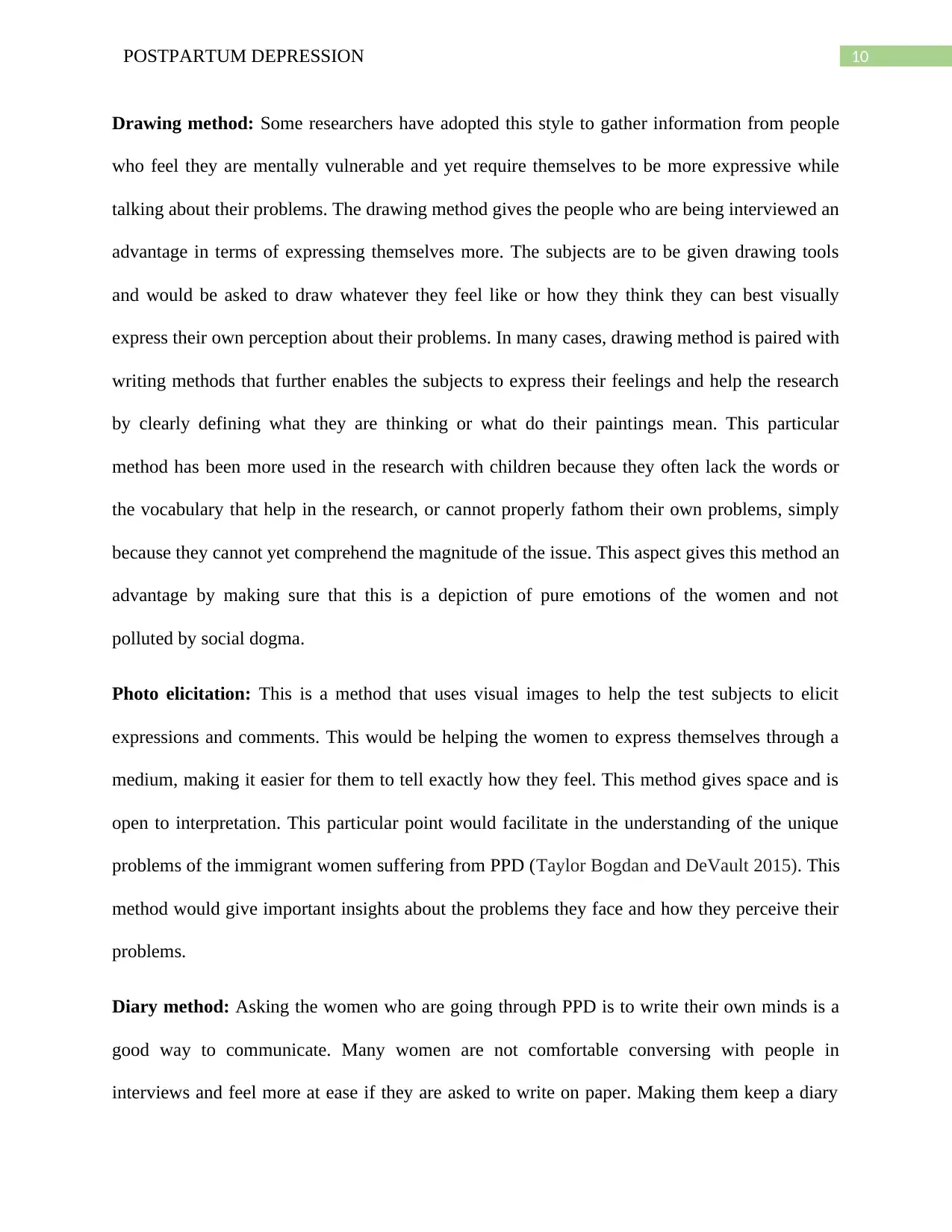
10POSTPARTUM DEPRESSION
Drawing method: Some researchers have adopted this style to gather information from people
who feel they are mentally vulnerable and yet require themselves to be more expressive while
talking about their problems. The drawing method gives the people who are being interviewed an
advantage in terms of expressing themselves more. The subjects are to be given drawing tools
and would be asked to draw whatever they feel like or how they think they can best visually
express their own perception about their problems. In many cases, drawing method is paired with
writing methods that further enables the subjects to express their feelings and help the research
by clearly defining what they are thinking or what do their paintings mean. This particular
method has been more used in the research with children because they often lack the words or
the vocabulary that help in the research, or cannot properly fathom their own problems, simply
because they cannot yet comprehend the magnitude of the issue. This aspect gives this method an
advantage by making sure that this is a depiction of pure emotions of the women and not
polluted by social dogma.
Photo elicitation: This is a method that uses visual images to help the test subjects to elicit
expressions and comments. This would be helping the women to express themselves through a
medium, making it easier for them to tell exactly how they feel. This method gives space and is
open to interpretation. This particular point would facilitate in the understanding of the unique
problems of the immigrant women suffering from PPD (Taylor Bogdan and DeVault 2015). This
method would give important insights about the problems they face and how they perceive their
problems.
Diary method: Asking the women who are going through PPD is to write their own minds is a
good way to communicate. Many women are not comfortable conversing with people in
interviews and feel more at ease if they are asked to write on paper. Making them keep a diary
Drawing method: Some researchers have adopted this style to gather information from people
who feel they are mentally vulnerable and yet require themselves to be more expressive while
talking about their problems. The drawing method gives the people who are being interviewed an
advantage in terms of expressing themselves more. The subjects are to be given drawing tools
and would be asked to draw whatever they feel like or how they think they can best visually
express their own perception about their problems. In many cases, drawing method is paired with
writing methods that further enables the subjects to express their feelings and help the research
by clearly defining what they are thinking or what do their paintings mean. This particular
method has been more used in the research with children because they often lack the words or
the vocabulary that help in the research, or cannot properly fathom their own problems, simply
because they cannot yet comprehend the magnitude of the issue. This aspect gives this method an
advantage by making sure that this is a depiction of pure emotions of the women and not
polluted by social dogma.
Photo elicitation: This is a method that uses visual images to help the test subjects to elicit
expressions and comments. This would be helping the women to express themselves through a
medium, making it easier for them to tell exactly how they feel. This method gives space and is
open to interpretation. This particular point would facilitate in the understanding of the unique
problems of the immigrant women suffering from PPD (Taylor Bogdan and DeVault 2015). This
method would give important insights about the problems they face and how they perceive their
problems.
Diary method: Asking the women who are going through PPD is to write their own minds is a
good way to communicate. Many women are not comfortable conversing with people in
interviews and feel more at ease if they are asked to write on paper. Making them keep a diary
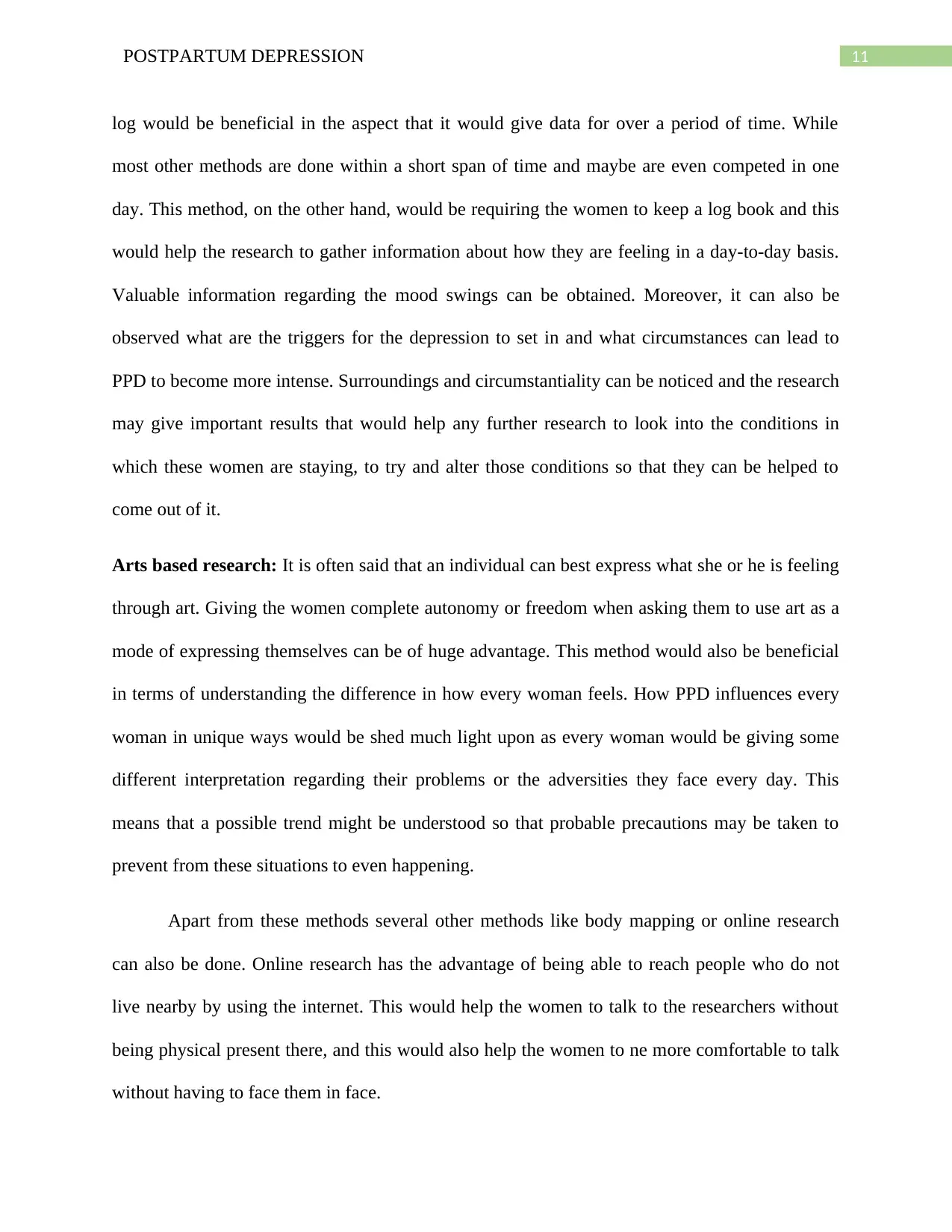
11POSTPARTUM DEPRESSION
log would be beneficial in the aspect that it would give data for over a period of time. While
most other methods are done within a short span of time and maybe are even competed in one
day. This method, on the other hand, would be requiring the women to keep a log book and this
would help the research to gather information about how they are feeling in a day-to-day basis.
Valuable information regarding the mood swings can be obtained. Moreover, it can also be
observed what are the triggers for the depression to set in and what circumstances can lead to
PPD to become more intense. Surroundings and circumstantiality can be noticed and the research
may give important results that would help any further research to look into the conditions in
which these women are staying, to try and alter those conditions so that they can be helped to
come out of it.
Arts based research: It is often said that an individual can best express what she or he is feeling
through art. Giving the women complete autonomy or freedom when asking them to use art as a
mode of expressing themselves can be of huge advantage. This method would also be beneficial
in terms of understanding the difference in how every woman feels. How PPD influences every
woman in unique ways would be shed much light upon as every woman would be giving some
different interpretation regarding their problems or the adversities they face every day. This
means that a possible trend might be understood so that probable precautions may be taken to
prevent from these situations to even happening.
Apart from these methods several other methods like body mapping or online research
can also be done. Online research has the advantage of being able to reach people who do not
live nearby by using the internet. This would help the women to talk to the researchers without
being physical present there, and this would also help the women to ne more comfortable to talk
without having to face them in face.
log would be beneficial in the aspect that it would give data for over a period of time. While
most other methods are done within a short span of time and maybe are even competed in one
day. This method, on the other hand, would be requiring the women to keep a log book and this
would help the research to gather information about how they are feeling in a day-to-day basis.
Valuable information regarding the mood swings can be obtained. Moreover, it can also be
observed what are the triggers for the depression to set in and what circumstances can lead to
PPD to become more intense. Surroundings and circumstantiality can be noticed and the research
may give important results that would help any further research to look into the conditions in
which these women are staying, to try and alter those conditions so that they can be helped to
come out of it.
Arts based research: It is often said that an individual can best express what she or he is feeling
through art. Giving the women complete autonomy or freedom when asking them to use art as a
mode of expressing themselves can be of huge advantage. This method would also be beneficial
in terms of understanding the difference in how every woman feels. How PPD influences every
woman in unique ways would be shed much light upon as every woman would be giving some
different interpretation regarding their problems or the adversities they face every day. This
means that a possible trend might be understood so that probable precautions may be taken to
prevent from these situations to even happening.
Apart from these methods several other methods like body mapping or online research
can also be done. Online research has the advantage of being able to reach people who do not
live nearby by using the internet. This would help the women to talk to the researchers without
being physical present there, and this would also help the women to ne more comfortable to talk
without having to face them in face.
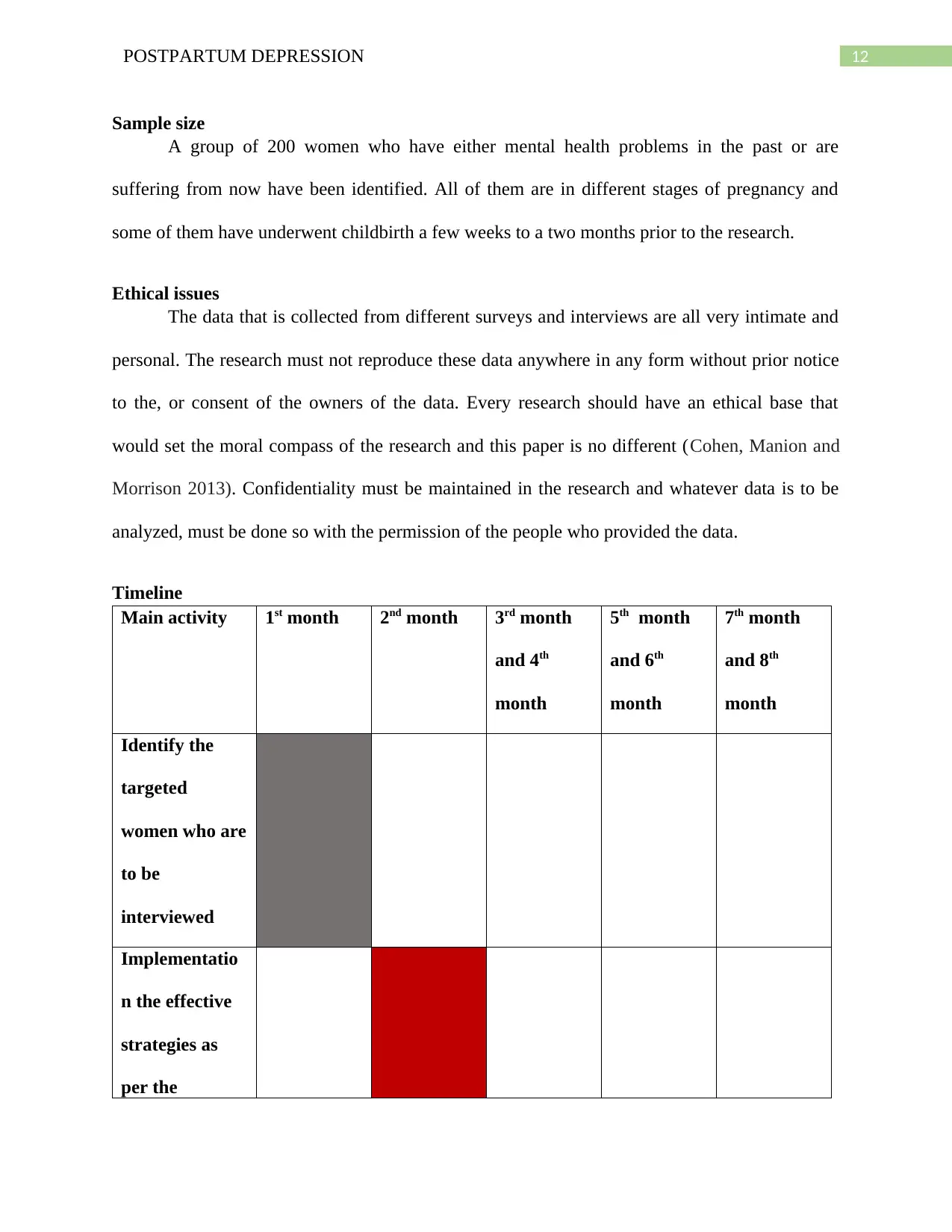
12POSTPARTUM DEPRESSION
Sample size
A group of 200 women who have either mental health problems in the past or are
suffering from now have been identified. All of them are in different stages of pregnancy and
some of them have underwent childbirth a few weeks to a two months prior to the research.
Ethical issues
The data that is collected from different surveys and interviews are all very intimate and
personal. The research must not reproduce these data anywhere in any form without prior notice
to the, or consent of the owners of the data. Every research should have an ethical base that
would set the moral compass of the research and this paper is no different (Cohen, Manion and
Morrison 2013). Confidentiality must be maintained in the research and whatever data is to be
analyzed, must be done so with the permission of the people who provided the data.
Timeline
Main activity 1st month 2nd month 3rd month
and 4th
month
5th month
and 6th
month
7th month
and 8th
month
Identify the
targeted
women who are
to be
interviewed
Implementatio
n the effective
strategies as
per the
Sample size
A group of 200 women who have either mental health problems in the past or are
suffering from now have been identified. All of them are in different stages of pregnancy and
some of them have underwent childbirth a few weeks to a two months prior to the research.
Ethical issues
The data that is collected from different surveys and interviews are all very intimate and
personal. The research must not reproduce these data anywhere in any form without prior notice
to the, or consent of the owners of the data. Every research should have an ethical base that
would set the moral compass of the research and this paper is no different (Cohen, Manion and
Morrison 2013). Confidentiality must be maintained in the research and whatever data is to be
analyzed, must be done so with the permission of the people who provided the data.
Timeline
Main activity 1st month 2nd month 3rd month
and 4th
month
5th month
and 6th
month
7th month
and 8th
month
Identify the
targeted
women who are
to be
interviewed
Implementatio
n the effective
strategies as
per the
Paraphrase This Document
Need a fresh take? Get an instant paraphrase of this document with our AI Paraphraser
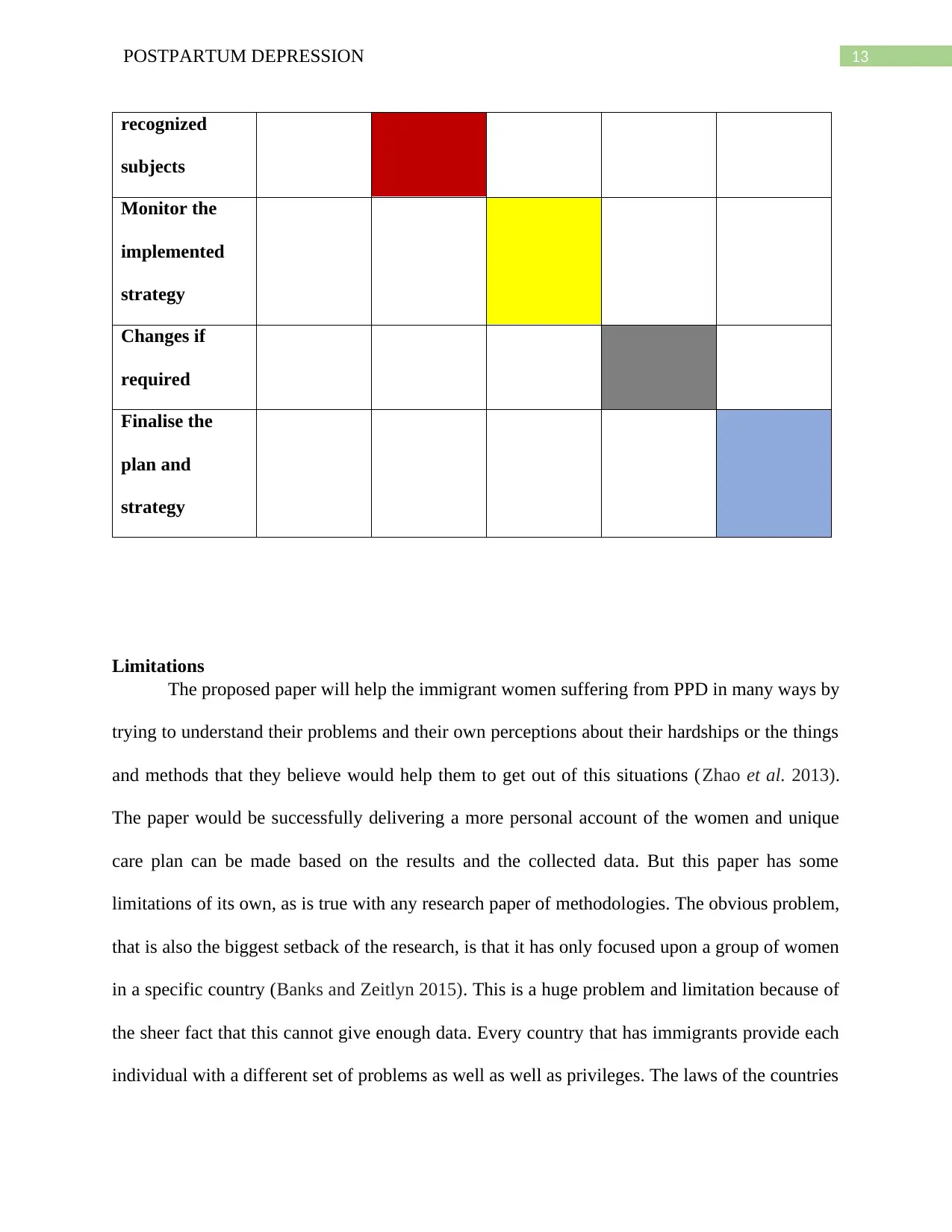
13POSTPARTUM DEPRESSION
recognized
subjects
Monitor the
implemented
strategy
Changes if
required
Finalise the
plan and
strategy
Limitations
The proposed paper will help the immigrant women suffering from PPD in many ways by
trying to understand their problems and their own perceptions about their hardships or the things
and methods that they believe would help them to get out of this situations (Zhao et al. 2013).
The paper would be successfully delivering a more personal account of the women and unique
care plan can be made based on the results and the collected data. But this paper has some
limitations of its own, as is true with any research paper of methodologies. The obvious problem,
that is also the biggest setback of the research, is that it has only focused upon a group of women
in a specific country (Banks and Zeitlyn 2015). This is a huge problem and limitation because of
the sheer fact that this cannot give enough data. Every country that has immigrants provide each
individual with a different set of problems as well as well as privileges. The laws of the countries
recognized
subjects
Monitor the
implemented
strategy
Changes if
required
Finalise the
plan and
strategy
Limitations
The proposed paper will help the immigrant women suffering from PPD in many ways by
trying to understand their problems and their own perceptions about their hardships or the things
and methods that they believe would help them to get out of this situations (Zhao et al. 2013).
The paper would be successfully delivering a more personal account of the women and unique
care plan can be made based on the results and the collected data. But this paper has some
limitations of its own, as is true with any research paper of methodologies. The obvious problem,
that is also the biggest setback of the research, is that it has only focused upon a group of women
in a specific country (Banks and Zeitlyn 2015). This is a huge problem and limitation because of
the sheer fact that this cannot give enough data. Every country that has immigrants provide each
individual with a different set of problems as well as well as privileges. The laws of the countries
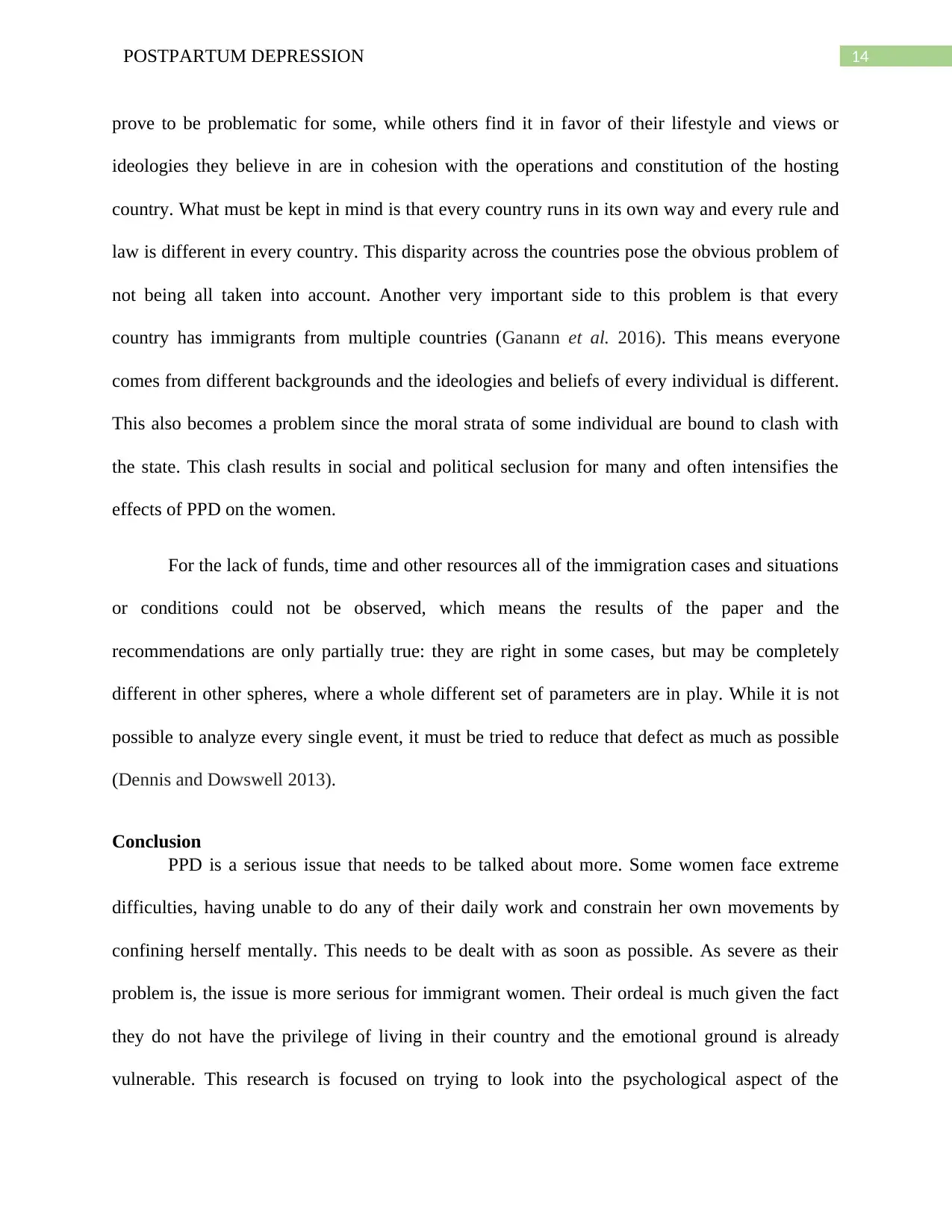
14POSTPARTUM DEPRESSION
prove to be problematic for some, while others find it in favor of their lifestyle and views or
ideologies they believe in are in cohesion with the operations and constitution of the hosting
country. What must be kept in mind is that every country runs in its own way and every rule and
law is different in every country. This disparity across the countries pose the obvious problem of
not being all taken into account. Another very important side to this problem is that every
country has immigrants from multiple countries (Ganann et al. 2016). This means everyone
comes from different backgrounds and the ideologies and beliefs of every individual is different.
This also becomes a problem since the moral strata of some individual are bound to clash with
the state. This clash results in social and political seclusion for many and often intensifies the
effects of PPD on the women.
For the lack of funds, time and other resources all of the immigration cases and situations
or conditions could not be observed, which means the results of the paper and the
recommendations are only partially true: they are right in some cases, but may be completely
different in other spheres, where a whole different set of parameters are in play. While it is not
possible to analyze every single event, it must be tried to reduce that defect as much as possible
(Dennis and Dowswell 2013).
Conclusion
PPD is a serious issue that needs to be talked about more. Some women face extreme
difficulties, having unable to do any of their daily work and constrain her own movements by
confining herself mentally. This needs to be dealt with as soon as possible. As severe as their
problem is, the issue is more serious for immigrant women. Their ordeal is much given the fact
they do not have the privilege of living in their country and the emotional ground is already
vulnerable. This research is focused on trying to look into the psychological aspect of the
prove to be problematic for some, while others find it in favor of their lifestyle and views or
ideologies they believe in are in cohesion with the operations and constitution of the hosting
country. What must be kept in mind is that every country runs in its own way and every rule and
law is different in every country. This disparity across the countries pose the obvious problem of
not being all taken into account. Another very important side to this problem is that every
country has immigrants from multiple countries (Ganann et al. 2016). This means everyone
comes from different backgrounds and the ideologies and beliefs of every individual is different.
This also becomes a problem since the moral strata of some individual are bound to clash with
the state. This clash results in social and political seclusion for many and often intensifies the
effects of PPD on the women.
For the lack of funds, time and other resources all of the immigration cases and situations
or conditions could not be observed, which means the results of the paper and the
recommendations are only partially true: they are right in some cases, but may be completely
different in other spheres, where a whole different set of parameters are in play. While it is not
possible to analyze every single event, it must be tried to reduce that defect as much as possible
(Dennis and Dowswell 2013).
Conclusion
PPD is a serious issue that needs to be talked about more. Some women face extreme
difficulties, having unable to do any of their daily work and constrain her own movements by
confining herself mentally. This needs to be dealt with as soon as possible. As severe as their
problem is, the issue is more serious for immigrant women. Their ordeal is much given the fact
they do not have the privilege of living in their country and the emotional ground is already
vulnerable. This research is focused on trying to look into the psychological aspect of the
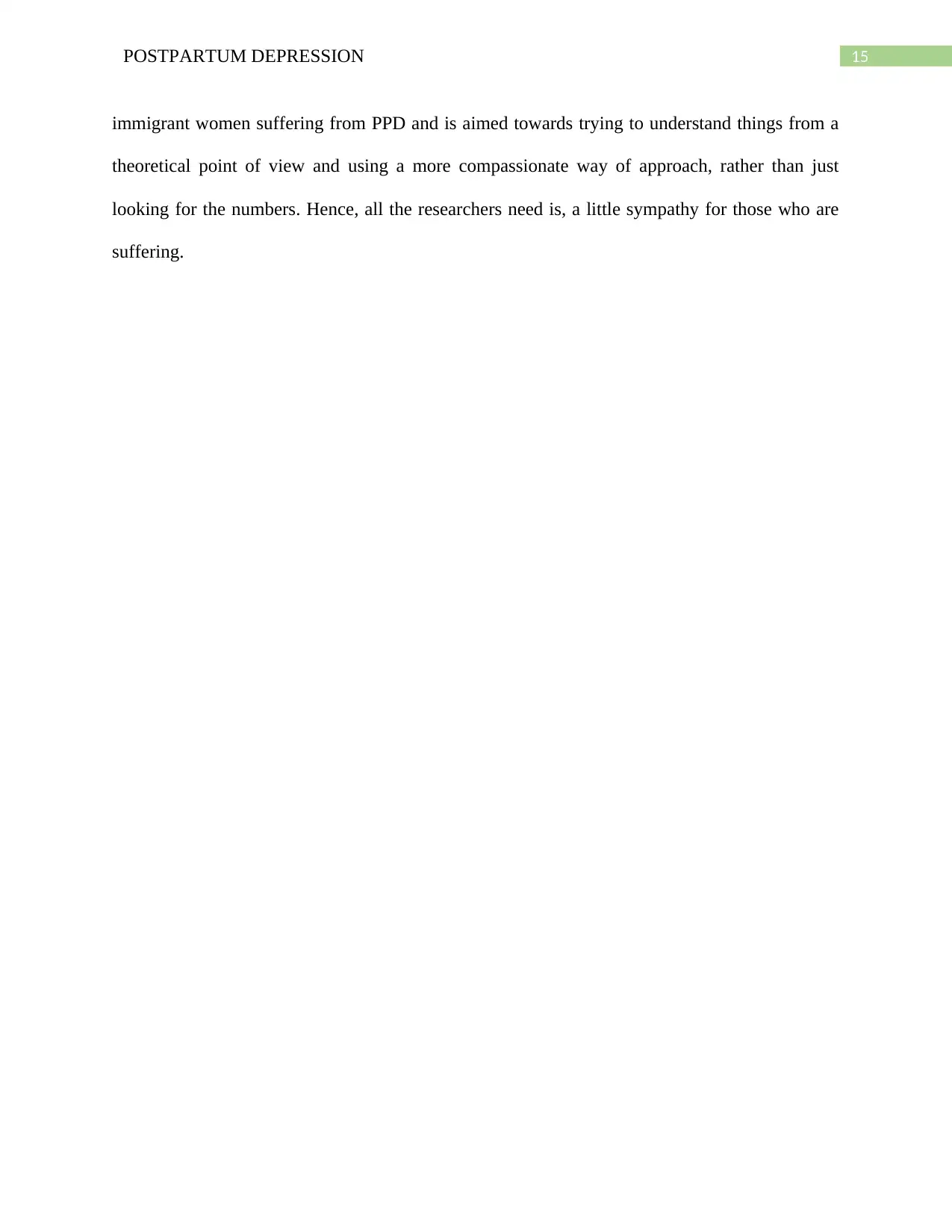
15POSTPARTUM DEPRESSION
immigrant women suffering from PPD and is aimed towards trying to understand things from a
theoretical point of view and using a more compassionate way of approach, rather than just
looking for the numbers. Hence, all the researchers need is, a little sympathy for those who are
suffering.
immigrant women suffering from PPD and is aimed towards trying to understand things from a
theoretical point of view and using a more compassionate way of approach, rather than just
looking for the numbers. Hence, all the researchers need is, a little sympathy for those who are
suffering.
Secure Best Marks with AI Grader
Need help grading? Try our AI Grader for instant feedback on your assignments.
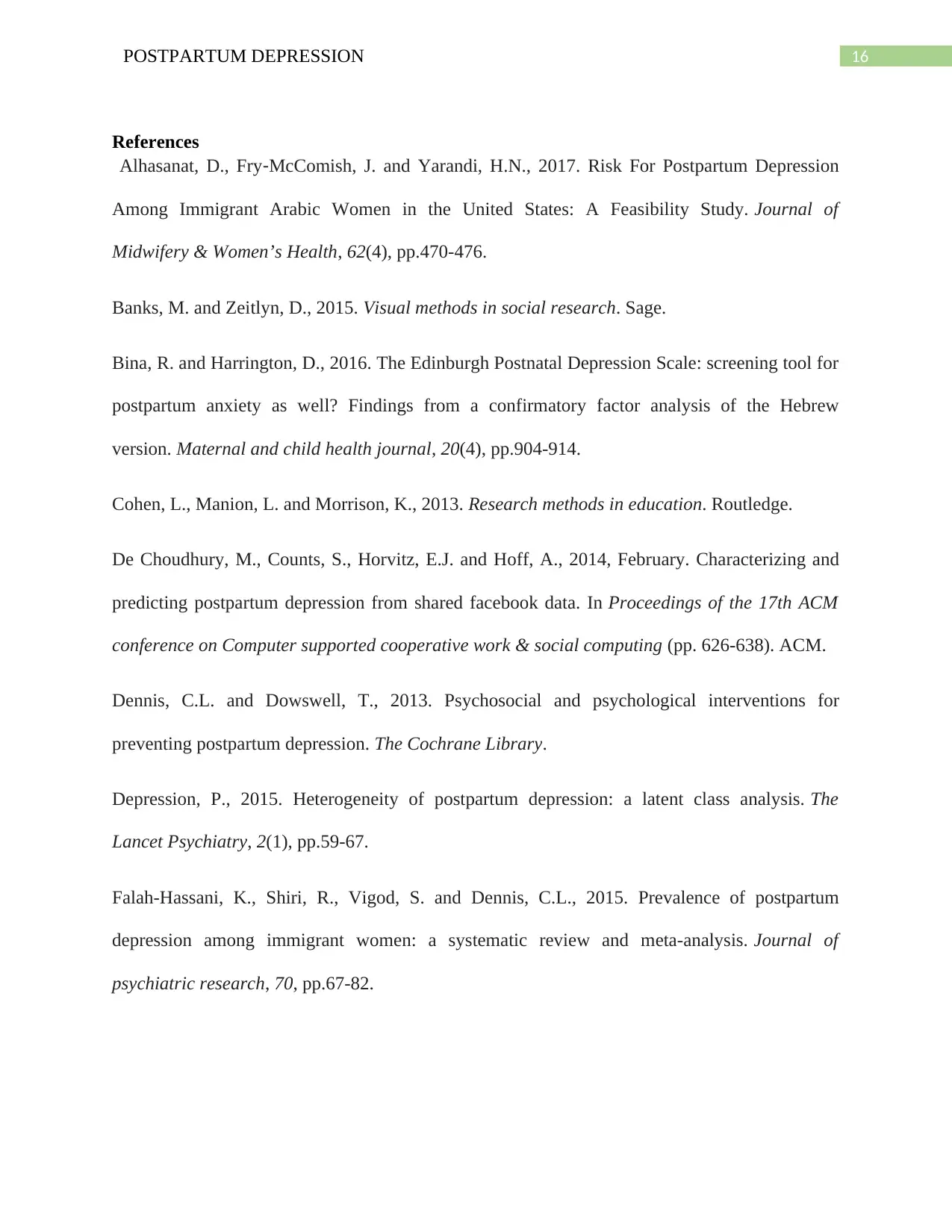
16POSTPARTUM DEPRESSION
References
Alhasanat, D., Fry‐McComish, J. and Yarandi, H.N., 2017. Risk For Postpartum Depression
Among Immigrant Arabic Women in the United States: A Feasibility Study. Journal of
Midwifery & Women’s Health, 62(4), pp.470-476.
Banks, M. and Zeitlyn, D., 2015. Visual methods in social research. Sage.
Bina, R. and Harrington, D., 2016. The Edinburgh Postnatal Depression Scale: screening tool for
postpartum anxiety as well? Findings from a confirmatory factor analysis of the Hebrew
version. Maternal and child health journal, 20(4), pp.904-914.
Cohen, L., Manion, L. and Morrison, K., 2013. Research methods in education. Routledge.
De Choudhury, M., Counts, S., Horvitz, E.J. and Hoff, A., 2014, February. Characterizing and
predicting postpartum depression from shared facebook data. In Proceedings of the 17th ACM
conference on Computer supported cooperative work & social computing (pp. 626-638). ACM.
Dennis, C.L. and Dowswell, T., 2013. Psychosocial and psychological interventions for
preventing postpartum depression. The Cochrane Library.
Depression, P., 2015. Heterogeneity of postpartum depression: a latent class analysis. The
Lancet Psychiatry, 2(1), pp.59-67.
Falah-Hassani, K., Shiri, R., Vigod, S. and Dennis, C.L., 2015. Prevalence of postpartum
depression among immigrant women: a systematic review and meta-analysis. Journal of
psychiatric research, 70, pp.67-82.
References
Alhasanat, D., Fry‐McComish, J. and Yarandi, H.N., 2017. Risk For Postpartum Depression
Among Immigrant Arabic Women in the United States: A Feasibility Study. Journal of
Midwifery & Women’s Health, 62(4), pp.470-476.
Banks, M. and Zeitlyn, D., 2015. Visual methods in social research. Sage.
Bina, R. and Harrington, D., 2016. The Edinburgh Postnatal Depression Scale: screening tool for
postpartum anxiety as well? Findings from a confirmatory factor analysis of the Hebrew
version. Maternal and child health journal, 20(4), pp.904-914.
Cohen, L., Manion, L. and Morrison, K., 2013. Research methods in education. Routledge.
De Choudhury, M., Counts, S., Horvitz, E.J. and Hoff, A., 2014, February. Characterizing and
predicting postpartum depression from shared facebook data. In Proceedings of the 17th ACM
conference on Computer supported cooperative work & social computing (pp. 626-638). ACM.
Dennis, C.L. and Dowswell, T., 2013. Psychosocial and psychological interventions for
preventing postpartum depression. The Cochrane Library.
Depression, P., 2015. Heterogeneity of postpartum depression: a latent class analysis. The
Lancet Psychiatry, 2(1), pp.59-67.
Falah-Hassani, K., Shiri, R., Vigod, S. and Dennis, C.L., 2015. Prevalence of postpartum
depression among immigrant women: a systematic review and meta-analysis. Journal of
psychiatric research, 70, pp.67-82.
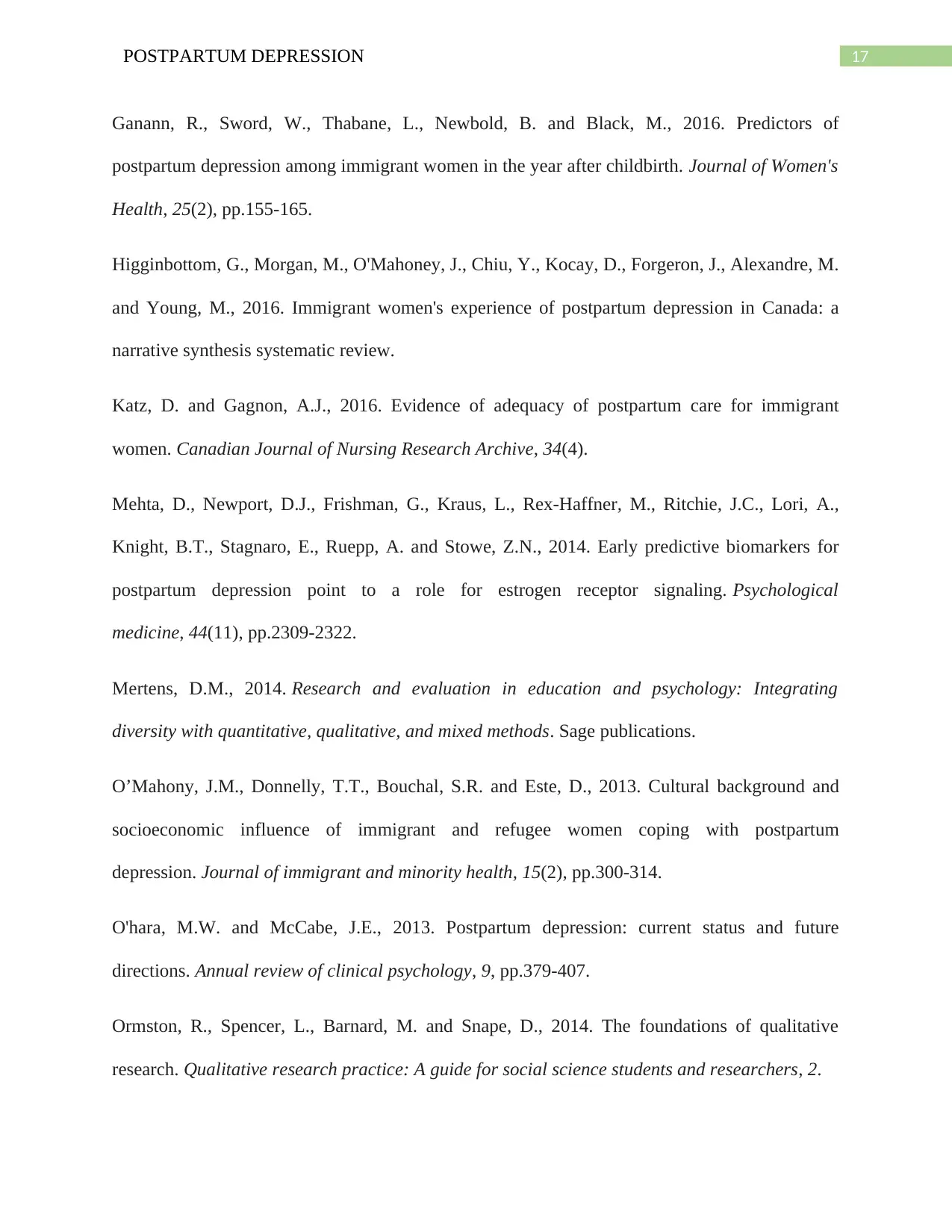
17POSTPARTUM DEPRESSION
Ganann, R., Sword, W., Thabane, L., Newbold, B. and Black, M., 2016. Predictors of
postpartum depression among immigrant women in the year after childbirth. Journal of Women's
Health, 25(2), pp.155-165.
Higginbottom, G., Morgan, M., O'Mahoney, J., Chiu, Y., Kocay, D., Forgeron, J., Alexandre, M.
and Young, M., 2016. Immigrant women's experience of postpartum depression in Canada: a
narrative synthesis systematic review.
Katz, D. and Gagnon, A.J., 2016. Evidence of adequacy of postpartum care for immigrant
women. Canadian Journal of Nursing Research Archive, 34(4).
Mehta, D., Newport, D.J., Frishman, G., Kraus, L., Rex-Haffner, M., Ritchie, J.C., Lori, A.,
Knight, B.T., Stagnaro, E., Ruepp, A. and Stowe, Z.N., 2014. Early predictive biomarkers for
postpartum depression point to a role for estrogen receptor signaling. Psychological
medicine, 44(11), pp.2309-2322.
Mertens, D.M., 2014. Research and evaluation in education and psychology: Integrating
diversity with quantitative, qualitative, and mixed methods. Sage publications.
O’Mahony, J.M., Donnelly, T.T., Bouchal, S.R. and Este, D., 2013. Cultural background and
socioeconomic influence of immigrant and refugee women coping with postpartum
depression. Journal of immigrant and minority health, 15(2), pp.300-314.
O'hara, M.W. and McCabe, J.E., 2013. Postpartum depression: current status and future
directions. Annual review of clinical psychology, 9, pp.379-407.
Ormston, R., Spencer, L., Barnard, M. and Snape, D., 2014. The foundations of qualitative
research. Qualitative research practice: A guide for social science students and researchers, 2.
Ganann, R., Sword, W., Thabane, L., Newbold, B. and Black, M., 2016. Predictors of
postpartum depression among immigrant women in the year after childbirth. Journal of Women's
Health, 25(2), pp.155-165.
Higginbottom, G., Morgan, M., O'Mahoney, J., Chiu, Y., Kocay, D., Forgeron, J., Alexandre, M.
and Young, M., 2016. Immigrant women's experience of postpartum depression in Canada: a
narrative synthesis systematic review.
Katz, D. and Gagnon, A.J., 2016. Evidence of adequacy of postpartum care for immigrant
women. Canadian Journal of Nursing Research Archive, 34(4).
Mehta, D., Newport, D.J., Frishman, G., Kraus, L., Rex-Haffner, M., Ritchie, J.C., Lori, A.,
Knight, B.T., Stagnaro, E., Ruepp, A. and Stowe, Z.N., 2014. Early predictive biomarkers for
postpartum depression point to a role for estrogen receptor signaling. Psychological
medicine, 44(11), pp.2309-2322.
Mertens, D.M., 2014. Research and evaluation in education and psychology: Integrating
diversity with quantitative, qualitative, and mixed methods. Sage publications.
O’Mahony, J.M., Donnelly, T.T., Bouchal, S.R. and Este, D., 2013. Cultural background and
socioeconomic influence of immigrant and refugee women coping with postpartum
depression. Journal of immigrant and minority health, 15(2), pp.300-314.
O'hara, M.W. and McCabe, J.E., 2013. Postpartum depression: current status and future
directions. Annual review of clinical psychology, 9, pp.379-407.
Ormston, R., Spencer, L., Barnard, M. and Snape, D., 2014. The foundations of qualitative
research. Qualitative research practice: A guide for social science students and researchers, 2.
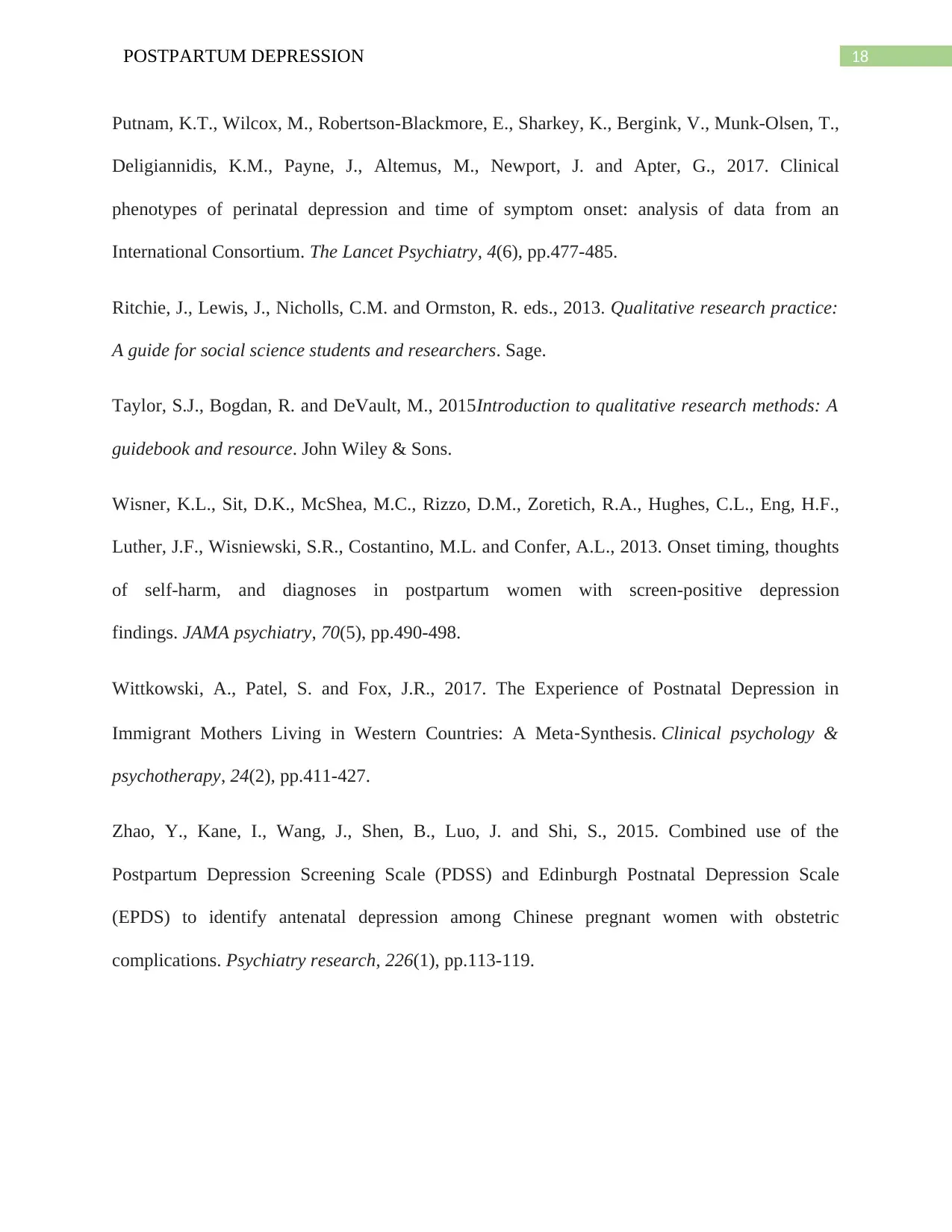
18POSTPARTUM DEPRESSION
Putnam, K.T., Wilcox, M., Robertson-Blackmore, E., Sharkey, K., Bergink, V., Munk-Olsen, T.,
Deligiannidis, K.M., Payne, J., Altemus, M., Newport, J. and Apter, G., 2017. Clinical
phenotypes of perinatal depression and time of symptom onset: analysis of data from an
International Consortium. The Lancet Psychiatry, 4(6), pp.477-485.
Ritchie, J., Lewis, J., Nicholls, C.M. and Ormston, R. eds., 2013. Qualitative research practice:
A guide for social science students and researchers. Sage.
Taylor, S.J., Bogdan, R. and DeVault, M., 2015Introduction to qualitative research methods: A
guidebook and resource. John Wiley & Sons.
Wisner, K.L., Sit, D.K., McShea, M.C., Rizzo, D.M., Zoretich, R.A., Hughes, C.L., Eng, H.F.,
Luther, J.F., Wisniewski, S.R., Costantino, M.L. and Confer, A.L., 2013. Onset timing, thoughts
of self-harm, and diagnoses in postpartum women with screen-positive depression
findings. JAMA psychiatry, 70(5), pp.490-498.
Wittkowski, A., Patel, S. and Fox, J.R., 2017. The Experience of Postnatal Depression in
Immigrant Mothers Living in Western Countries: A Meta‐Synthesis. Clinical psychology &
psychotherapy, 24(2), pp.411-427.
Zhao, Y., Kane, I., Wang, J., Shen, B., Luo, J. and Shi, S., 2015. Combined use of the
Postpartum Depression Screening Scale (PDSS) and Edinburgh Postnatal Depression Scale
(EPDS) to identify antenatal depression among Chinese pregnant women with obstetric
complications. Psychiatry research, 226(1), pp.113-119.
Putnam, K.T., Wilcox, M., Robertson-Blackmore, E., Sharkey, K., Bergink, V., Munk-Olsen, T.,
Deligiannidis, K.M., Payne, J., Altemus, M., Newport, J. and Apter, G., 2017. Clinical
phenotypes of perinatal depression and time of symptom onset: analysis of data from an
International Consortium. The Lancet Psychiatry, 4(6), pp.477-485.
Ritchie, J., Lewis, J., Nicholls, C.M. and Ormston, R. eds., 2013. Qualitative research practice:
A guide for social science students and researchers. Sage.
Taylor, S.J., Bogdan, R. and DeVault, M., 2015Introduction to qualitative research methods: A
guidebook and resource. John Wiley & Sons.
Wisner, K.L., Sit, D.K., McShea, M.C., Rizzo, D.M., Zoretich, R.A., Hughes, C.L., Eng, H.F.,
Luther, J.F., Wisniewski, S.R., Costantino, M.L. and Confer, A.L., 2013. Onset timing, thoughts
of self-harm, and diagnoses in postpartum women with screen-positive depression
findings. JAMA psychiatry, 70(5), pp.490-498.
Wittkowski, A., Patel, S. and Fox, J.R., 2017. The Experience of Postnatal Depression in
Immigrant Mothers Living in Western Countries: A Meta‐Synthesis. Clinical psychology &
psychotherapy, 24(2), pp.411-427.
Zhao, Y., Kane, I., Wang, J., Shen, B., Luo, J. and Shi, S., 2015. Combined use of the
Postpartum Depression Screening Scale (PDSS) and Edinburgh Postnatal Depression Scale
(EPDS) to identify antenatal depression among Chinese pregnant women with obstetric
complications. Psychiatry research, 226(1), pp.113-119.
1 out of 19
Related Documents
Your All-in-One AI-Powered Toolkit for Academic Success.
+13062052269
info@desklib.com
Available 24*7 on WhatsApp / Email
![[object Object]](/_next/static/media/star-bottom.7253800d.svg)
Unlock your academic potential
© 2024 | Zucol Services PVT LTD | All rights reserved.





